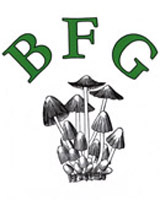SEARCH all entries via Masterlist Index of Latin or English names
A B C D E F G H I J K L M N O P Q R S T U V W X Y Z
Rare sightings New to Buckinghamshire New to UK New to Science
| E |
|
| Echinoderma asperum (Freckled Dapperling) | |
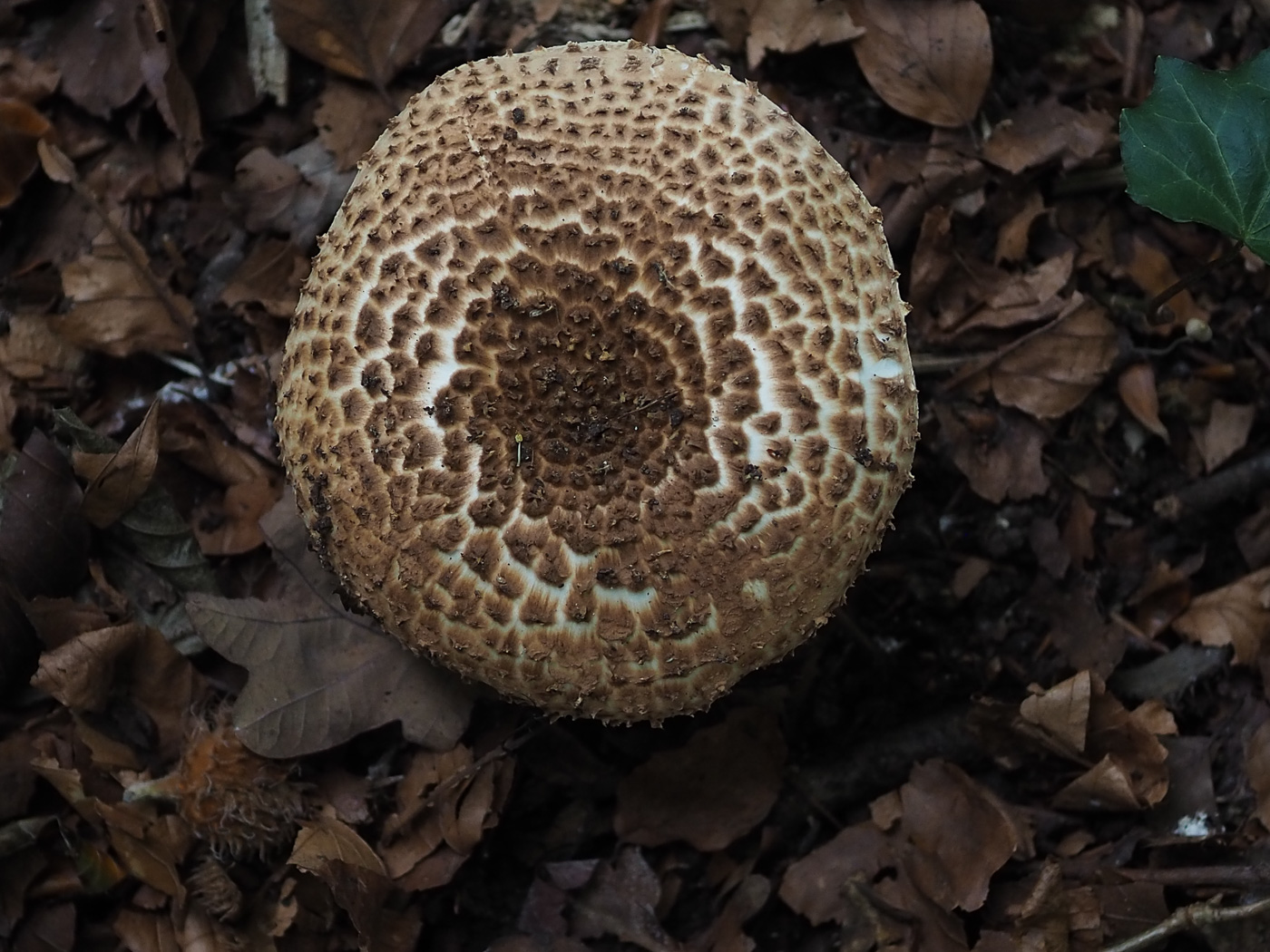
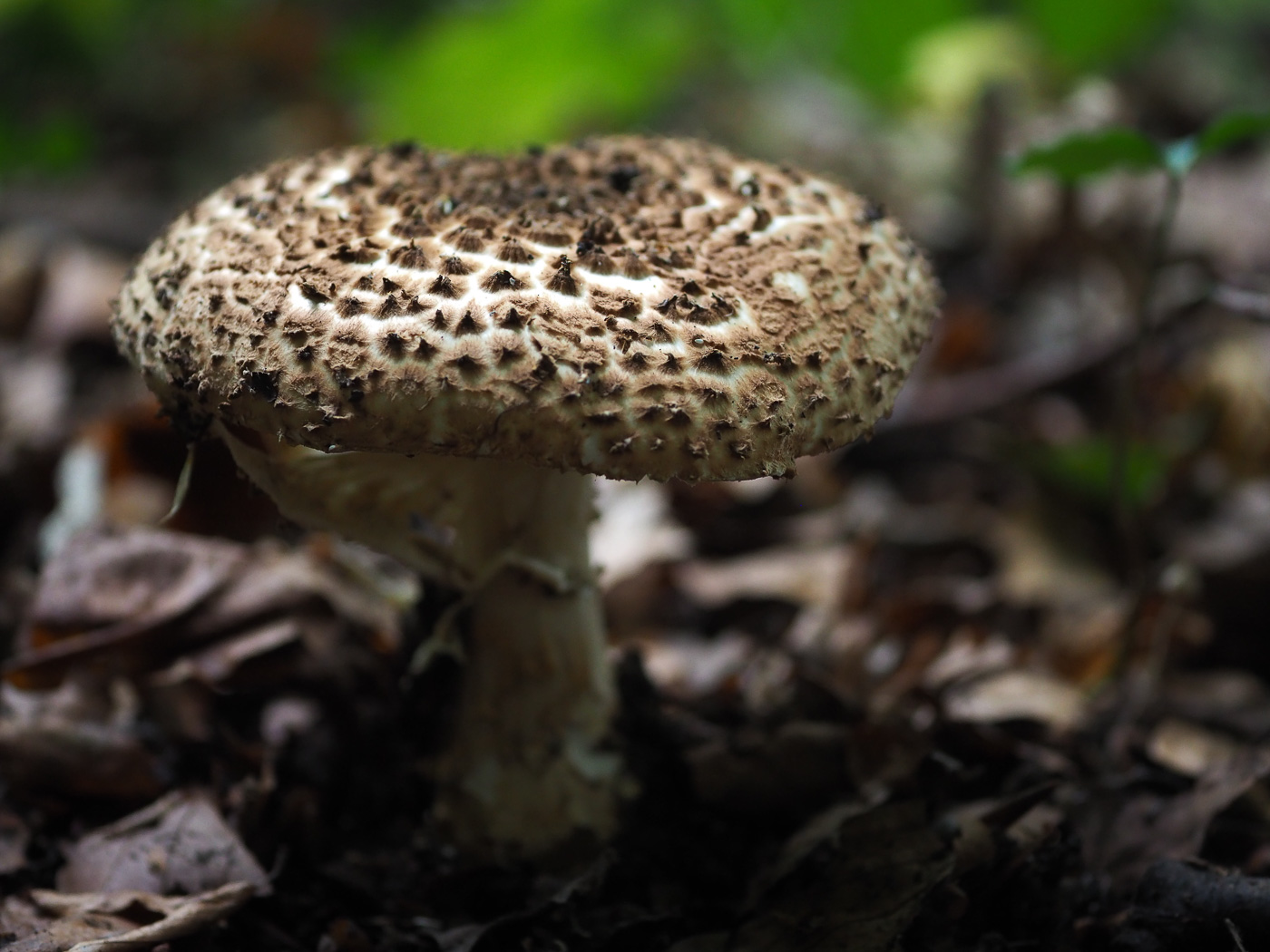 |
Oct 19, 2025. In Tinkers Wood John Catterson spied this singleton, previously in genus Lepiota, with its typical pyramidal scales on the cap which make it instantly recognisable in the field. It has the white free gills of all Dapperlings, also a ring on the stem which is often soon lost. There is a much rarer similar species, E. perplexum, which however, is a duller greyer colour. |

 |
Nov 3, 2023. In Chalfont St. Peter Jesper Launder found this attractive species previously in genus Lepiota. This is quite a big Dapperling though not as large as the Parasols, and is by far the commonest of the strongly scaly-capped species now moved to this newish genus. The gills here are still covered by the thick membrane which later falls away to form a substantial ring on the stem. The species is extremely toxic. |

 |
Oct 28, 2021. In Naphill Common Sarah Ebdon found this attractive species which she didn't recognise and understandably placed in the genus Amanita - after all it has white free gills and a ring on the stem which has a swollen base and the cap is not that dissimilar to maybe a Blusher or even A. echinocephala (Solitary Amanita). Previously in Lepiota, this is a large and substantial species (though not as large as the Macrolepiotas - Parasols) and one feature to note which separates these genera from Amanita is that the white or greyish 'spots' on the cap of Amanita are remnants of its universal veil and will rub off with your finger - in fact have often been washed off by rain in patches or entirely. In Lepiota and related genera the cap 'scales' are basically brown and not white and are formed when the cap surface fibres stretch and then snap as the cap expands. Therefore they are part of the surface and will not rub off but could be peeled off. Incidentally with a scope the spores of Amanita and Lepiota are completely different shape. |
 |
Sep 17, 2021. In Rushbeds Wood Joanna Dodsworth found this beautiful specimen in woody litter. (Better known under its previous name Lepiota aspera, this is one of a few species moved into the newly created Echinoderma having notably scaly caps.) Not rare, it is always a delight to find especially when as pristine as this specimen where the ring on the stem is flared out like a skirt. Note also the white crowded gills (which are free - not seen here) typical of all Dapperlings though not all species have a ring on the stem and many are much smaller than this species which can have a cap up to 15 cm or more across. |
 |
Oct 7, 2020. Better known as Lepiota aspera, this impressive and beautiful species was found in a shrub bed at Benhams, a private garden near Fawley, by Richard Fortey (photo Penny Cullington). Note the crowded white gills and skirtlike ring on the stem which often has chestnut brown raised scales like those on the distinctive cap. This quite common species has an unpleasant smell and can get to 10cm across or more. Superficially similar to an Amanita (having a scaly cap, white gills and a prominent ring on the stem) note the lack of volva at the stem base. This species is |
| Echinoderma jacobi (a Dapperling with no English name) | |
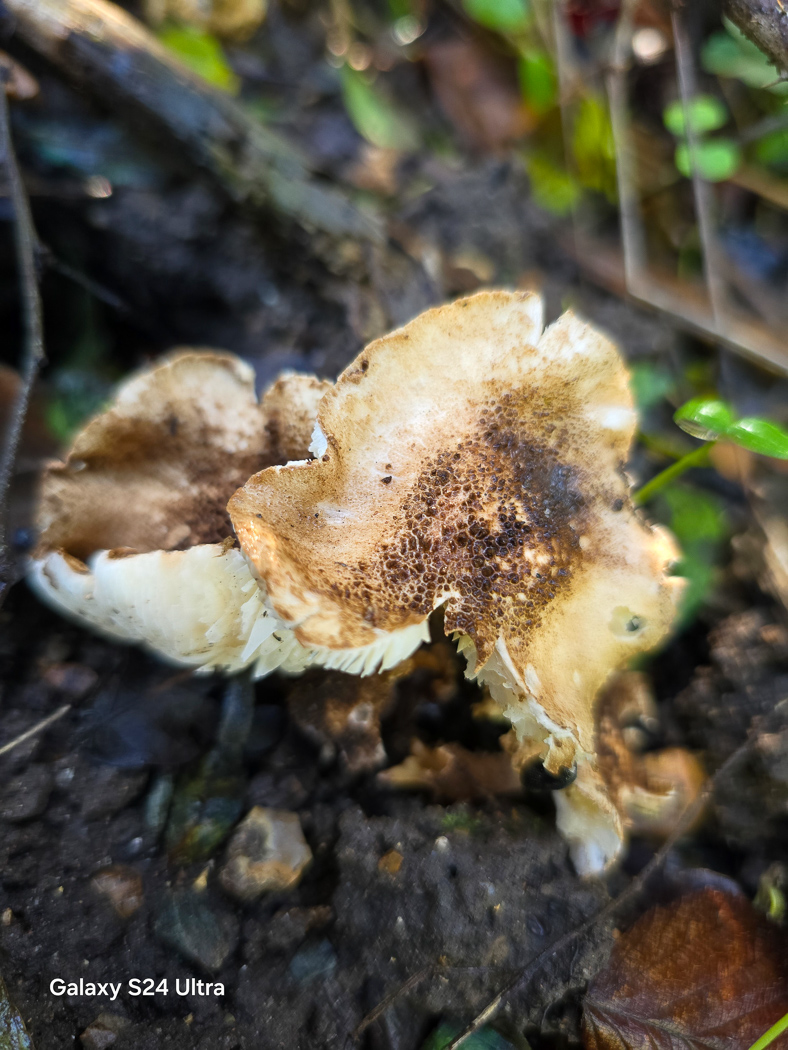
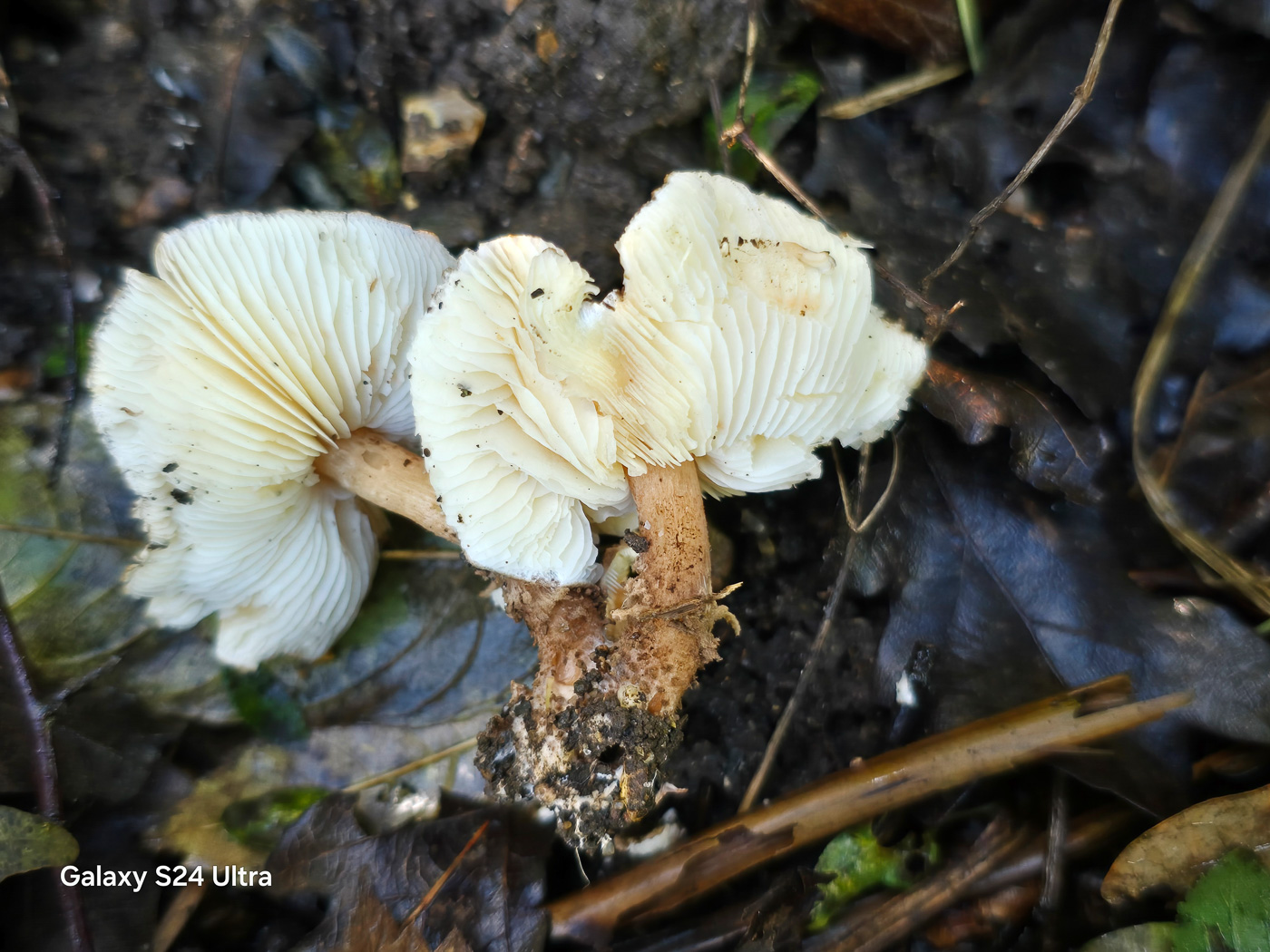 |
Oct 20, 2024. |
| Echinoderma perplexum (Warty Dapperling) | |
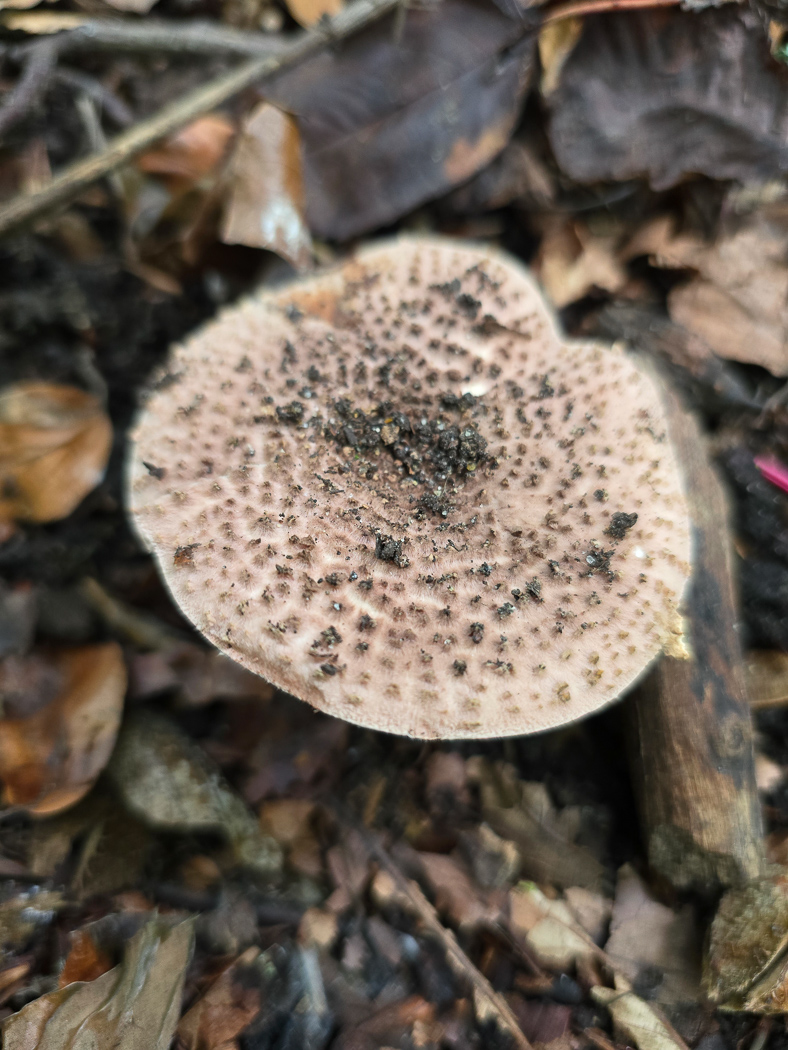
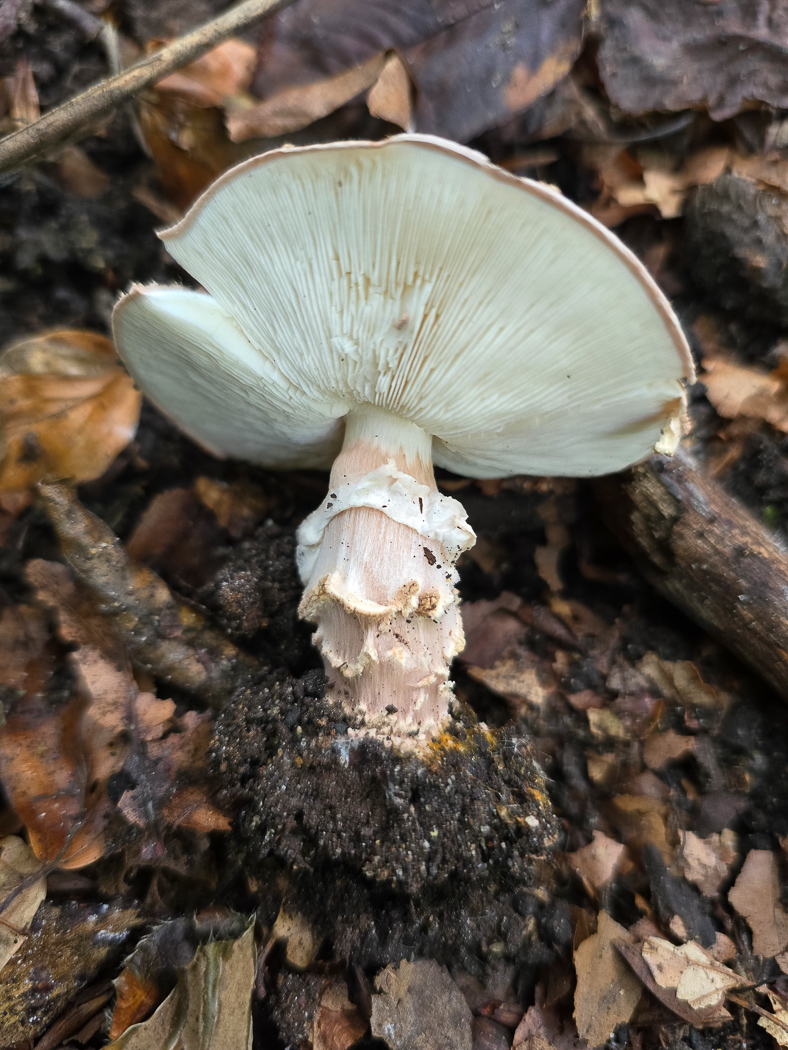 |
Oct 2, 2025. |


 |
Oct 11, 2021. |
| Elaphomyces muricatus (Marbled False Truffle) | |
 |
Jun 5, 2024. Under Lime and Oak at Stoke Poges Memorial Gardens Jesper Launder was looking for 'dig holes' and uncovered good numbers of this truffle-like ascomycete which he found new to the county in Jordans Village last year and also at this site though under Birch. He reports that at least half the holes he found today had specimens still in them, presumably indicating that whatever had made the holes (squirrels or mice) were disturbed before they were able to claim their prize! |

 |
May 21, 2023. In Crutches Wood, Jordans, Jesper Launder went searching for truffles and was pleased to find several of these beauties - new to the county today. He described them as quite rough to the feel with raised warts and a marbled peridium (inner casing) compared to E. granulatus which he found also new to the county the previous day on our Stoke Common walk! (See Penny's report for images to compare.) Needless to say, this is a first for Finds. Photo 2 is of another collection made by Jesper from Stoke Poges Memorial Gardens on June 24th. |
| Encoelia furfuracea (Spring Hazelcup) | |
 |
Feb 12, 2025. In Jordans Village on dead but attached Hazel Jesper Launder spotted this somewhat inconspicuous ascomycete which however is not rare wherever Hazel is present. One needs to know to look out for it on this host in Spring otherwise it is very easily missed. |

 |
May 8, 2021. On a path near Jordans Jesper Launder first noticed this good collection of cups on standing but presumably dying Hazel on April 27th (photo 1) when it was looking somewhat desiccated. Then 10 days later he found the same material completely rejuvenated after recent rain (photo 2) - what a transformation! This is a particularly impressive group of a species considered not common but occasional and host specific on Hazel. |
 |
Feb 5, 2021. Joanna Dodsworth spotted this small typically springtime Ascomycete on fallen Hazel in Rushbeds Wood. Our other nine county records range from late November through to March from four different sites, most often Rushbeds Wood no doubt owing to the numbers of Hazel found here - its commonest host. It can apparently occasionally be found on Alder as well. A nice find by Joanna. |
| Enerthenema papillatum (a slime Mould with no English name) | |
 |
Aug 3, 2025. On fallen Pine at Burnham Beeches Barry Webb found this tiny but delicately beautiful species. Each fruiting body is only 1.5mm tall and is in fact easily distinguishable from other similar stalked brown slime moulds by its central 'apical disc' seen clearly here. This appears to be new to the site and we have just six previous county records: three from the previous century recorded by expert Bruce Ing, then none till Barry started finding and identifying it in 2020. Like very many slime moulds it is probably common but under-recorded due to its size and lack of the necessary skills and specialised knowledge to find it. |
 |
Dec 30, 2021. On a fallen Beech branch in Hodgemoor Woods Barry found this tiny species. For more notes and images see Barry's separate page in Members' Finds. |
 |
Aug 22, 2020. In Penn Wood Barry Webb found these tiny specimens growing on rotting fallen Beech. This is the only species of the genus found in the UK and we have just three previous records from the north of the county, the most recent of which was in 2001. |
| Entoloma ameides (Bubblegum Pinkgill) | |
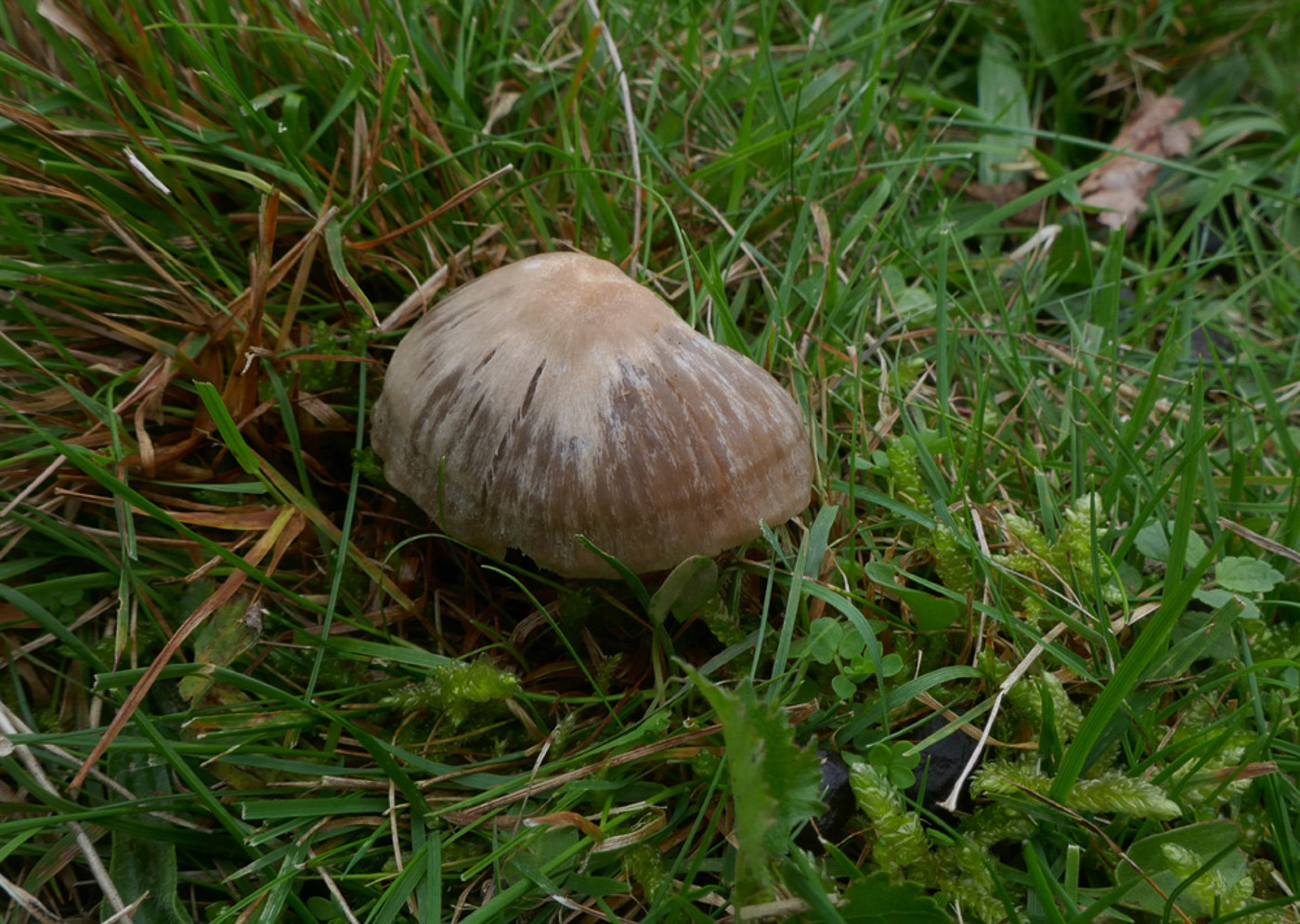
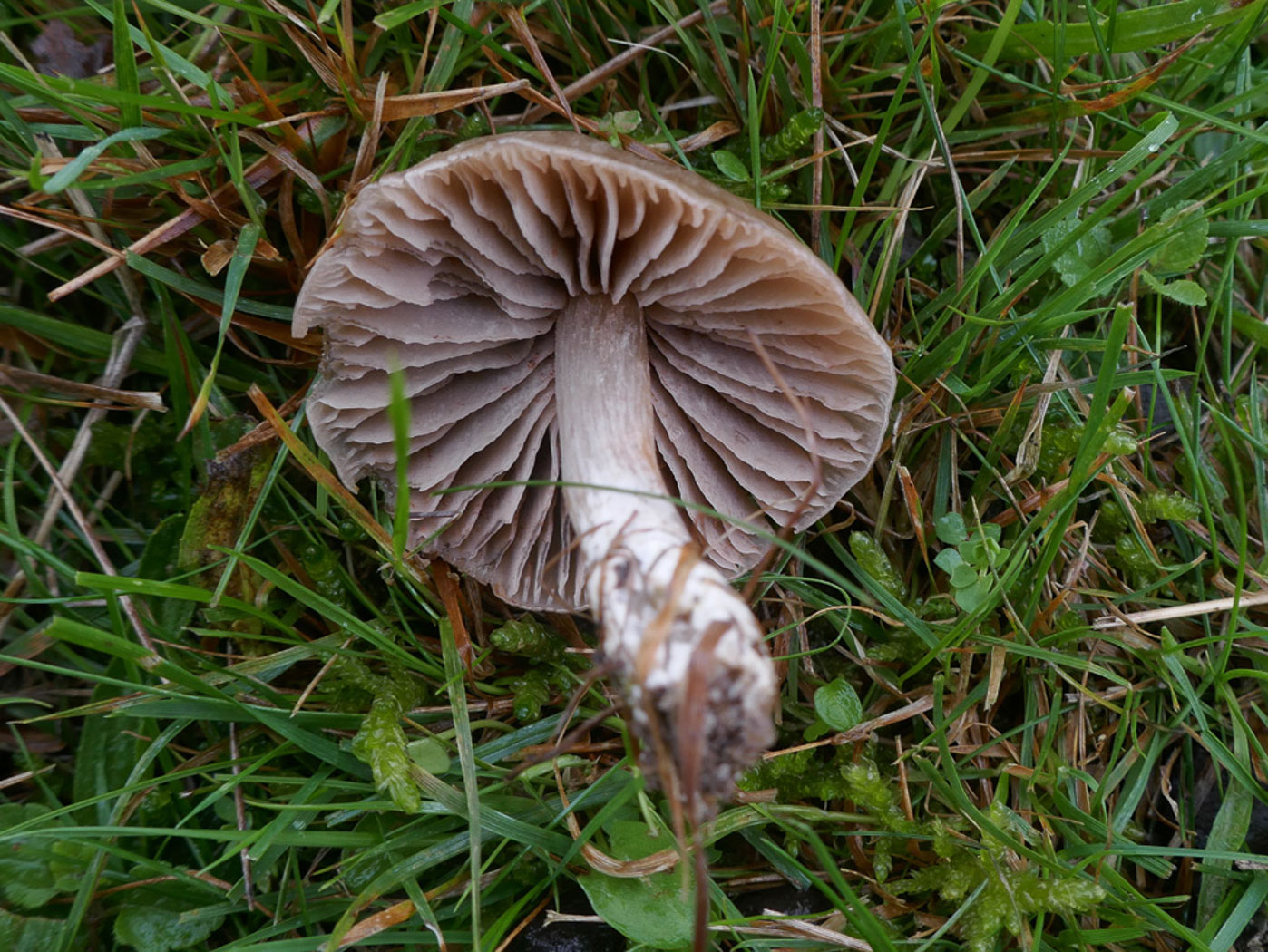 |
Sep 26, 2024. In a grassy patch at Stampwell Farm Jackie Ewan found this singleton Pinkgill and took it home to work on, noting the odd smell which was not mealy as quite a few of this genus are. The microscopic characters keyed out to this quite unusual species which we don't often record. |


 |
Jul 16, 2023. In a grassy path edge in Bernwood Forest Jesper Launder caught his eye on this LBJ, recognised the genus from its pink gills and general jizz, then noticed its distinctive smell: not of meal / flour as in many of the genus but of bubblegum! This occasional grassland species is renowned for its unique smell which makes for a quick and easy check with a scope at home to confirm its identity. (Otherwise one can spend fruitless hours struggling through a lengthy and complicated key for this genus!). Photo 3 was taken by Penny when she found the same species in a grassy glade at Kings Wood Tylers Green three days later. We have a handful of county records for this unusual grassland species, and this is a new entry for Finds. |
| Entoloma bloxamii (Big Blue Pinkgill) | |


|
Nov 24, 2020. |
| Entoloma chalybeum (Indigo Pinkgill)
| |


 |
Sep 28, 2023. Having been alerted by Jim Wills to the fact that there were small blue Pinkgills fruiting at the moment, Penny made a visit to Prestwood Churchyard and was certainly rewarded. Just a couple of feet into the short grassy area she found her first collection, swiftly followed by many more dotted about and intermixed with some brown capped Pinkgills (which went unidentified!). Work at home was needed because this is a very tricky genus (possibly Penny's least favourite!). There are many very similar small grassland Pinkgills, some with deep blue caps and stems, some with blue caps and brown stems and vice versa, some smooth, some not, some with a coloured gill edge, some not, etc etc. Microscopy is essential and often not easy to interpret, furthermore the keys are hard to follow and somewhat technical. Not for the faint-hearted. However, Penny had photos of a sequenced collection of this species from Penn Street Churchyard in two years ago to compare, and the roughened almost scaly cap surface plus faintly coloured gill edge together with microscopic features were convincing. See in Finds 2021 August 14th. |


 |
Aug 14, 2021. In mown grass in Penn Street Churchyard Penny was pleased to find several fruitbodies of a smallish distinctly blue Pinkgill (this colour on stem or cap, or both as in this case, placing it in Section Leptonia). At first she thought she had two different species because the smaller young caps were deep blue whereas growing a little further away were the larger browner caps which were more striate with the surface disrupting to minutely scaly. However, a scope revealed identical spores in both collections with other microscopic characters also matching, but following various keys lead somewhat dubiously to a rare species which seemed unlikely. The collection was therefore dried and eventually sequenced, which was just as well because it turned out to be something much less unusual though still with only three previous county records. It is worth comparing with a collection in Finds dated July 12th, this being E. chalybeum var. lazulinum which differs in having a translucent outer cap. |
| Entoloma chalybeum var. lazulinum (Indigo Pinkgill) | |
 |
Jul 12, 2021. |
| Entoloma clypeatum (Shield Pinkgill) | |
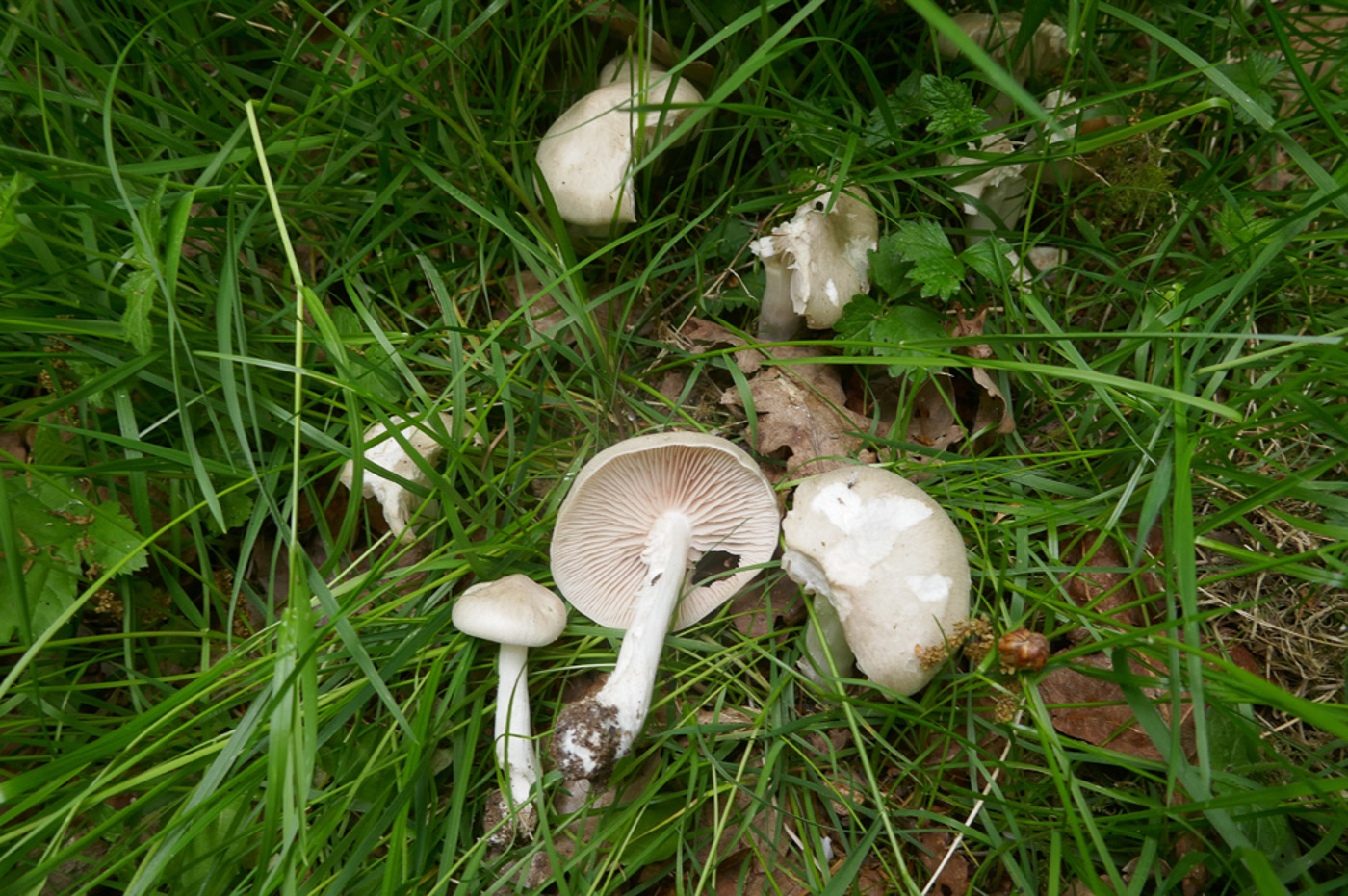
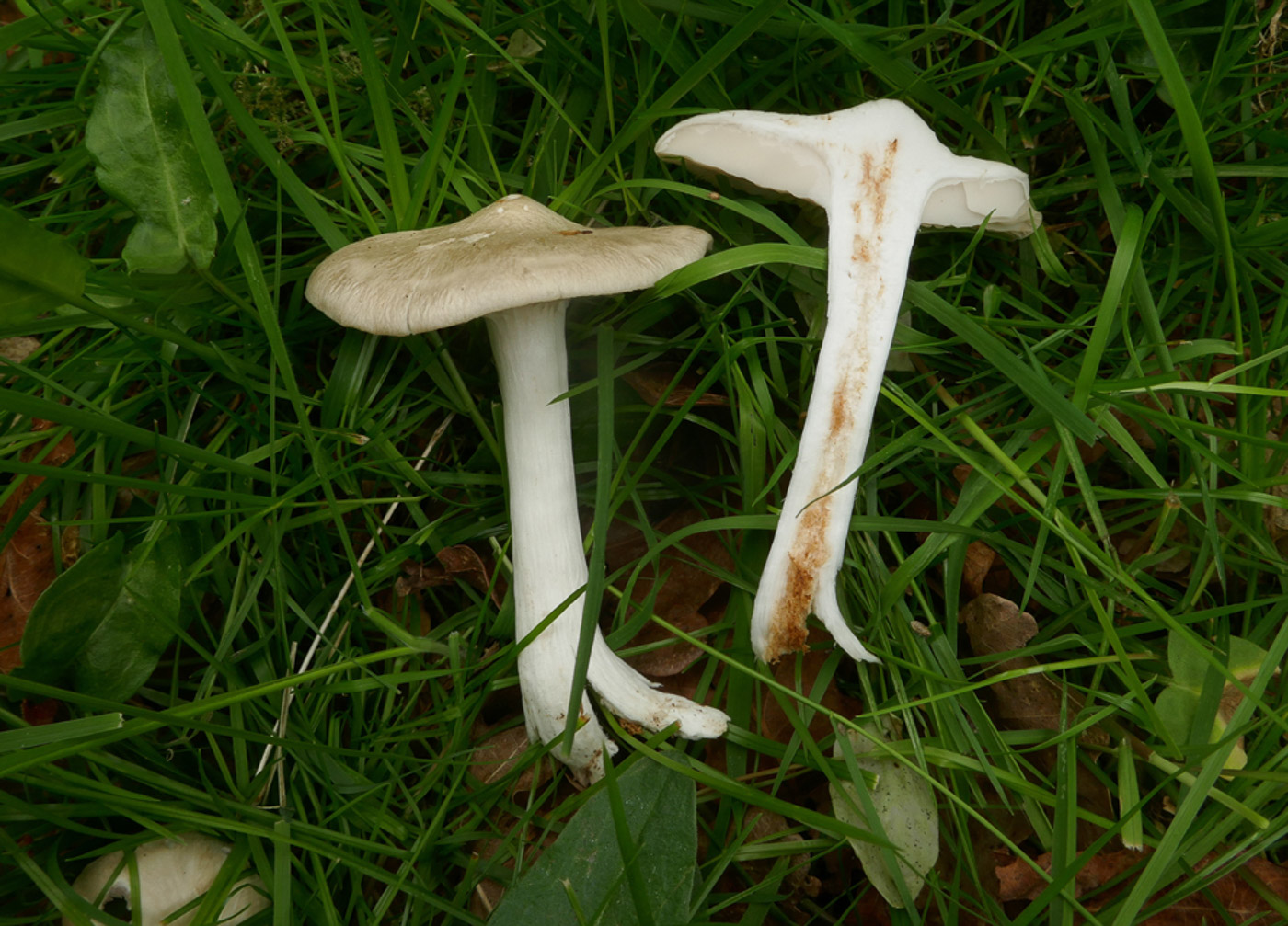
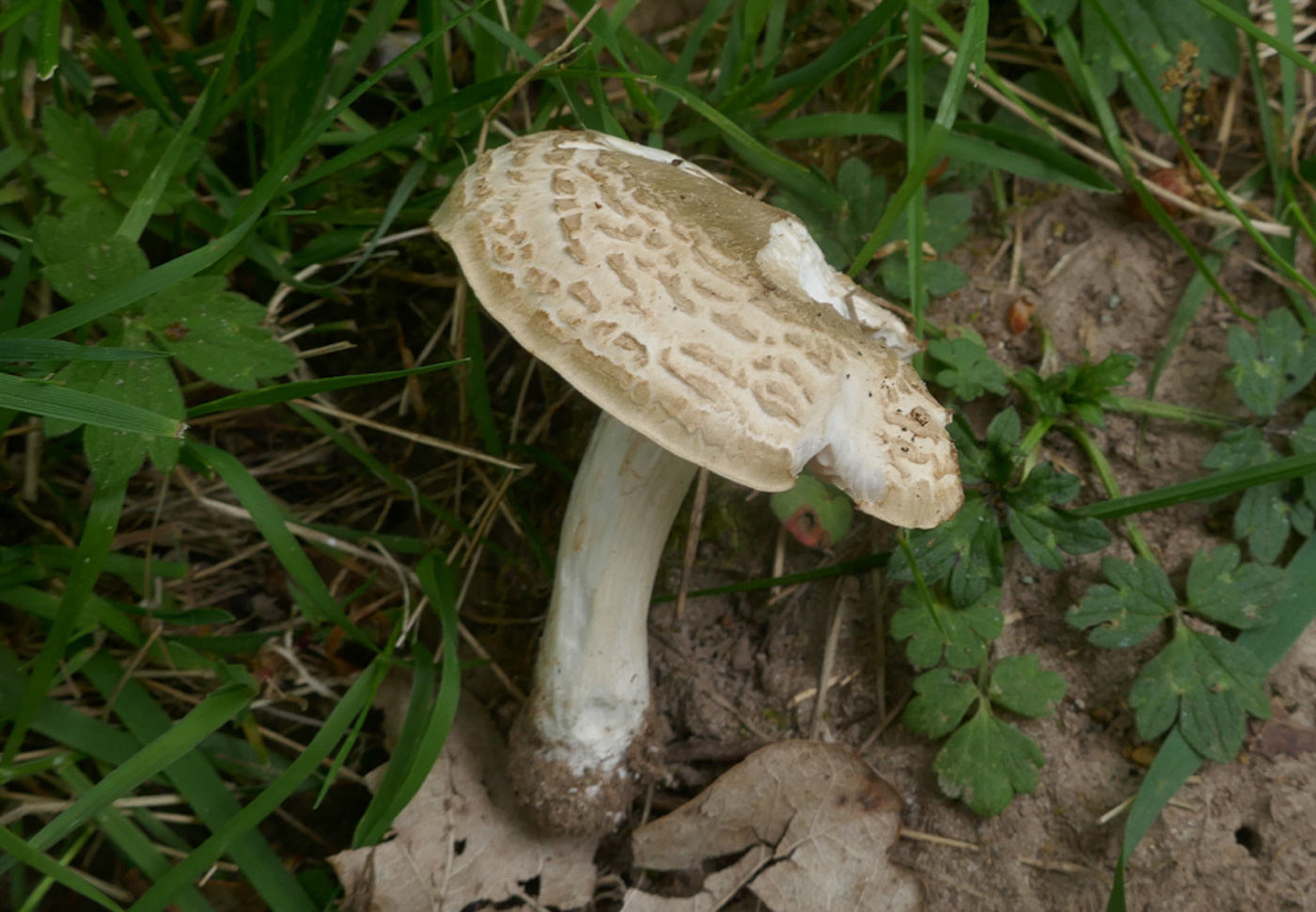 |
May 6, 2025. At Stampwell Farm Jackie Ewan was please to find this species beginning to fruit under the Plum suckers in a grassy spot where she's found it for several years at this time. This is quite a sizeable Pinkgill which favours Prunus and occurs in late spring so its timing is spot on here. Note how one of the caps looks unusually broken up and cracked making it more like perhaps an Agrocybe - no doubt as a result of exposure to the hot sun.
|
 |
May 18, 2022. At Stampwell Farm Jackie Ewan found this quite common Springtime Pinkgill growing amongst some Plum suckers in the same spot as it was found last year almost to the week! |
 |
Mar 8, 2022. In a private garden in Brill Joanna Dodsworth found this Spring to early Summer fruiting species - not one of your small LBJs as many of this genus are, but quite a chunky sizeable species and one which associates with Hawthorn and other woody members of the Rosaceae family. It has a mealy smell and the cap can get to 10 cm across or more, and - as found here - often occurs in rosebeds in gardens. |


 |
May 20, 2021. Jesper Launder found this Spring fruiting species in soil / Hawthorn scrub whilst walking at Beaconsfield Golf Club. It is one of only a very few Pinkgills to be found at this time which makes it easier to identify, especially as it is alone in fruiting under Rosaceae (to which Hawthorn belongs), often to be found in hedgerows and gardens as well as at woodland edges. Though at first glance it is similar to the genus Pluteus (Shield, and also with pink gills) that species only grows on wood and the gills are free, not adnate (adjoining the top of the stem) as here. We have a handful of sites where it has previously been recorded. Photo 3 shows a large collection made at Stampwell Farm by Penny a few days later. |
| Entoloma conferendum (Star Pinkgill) | |
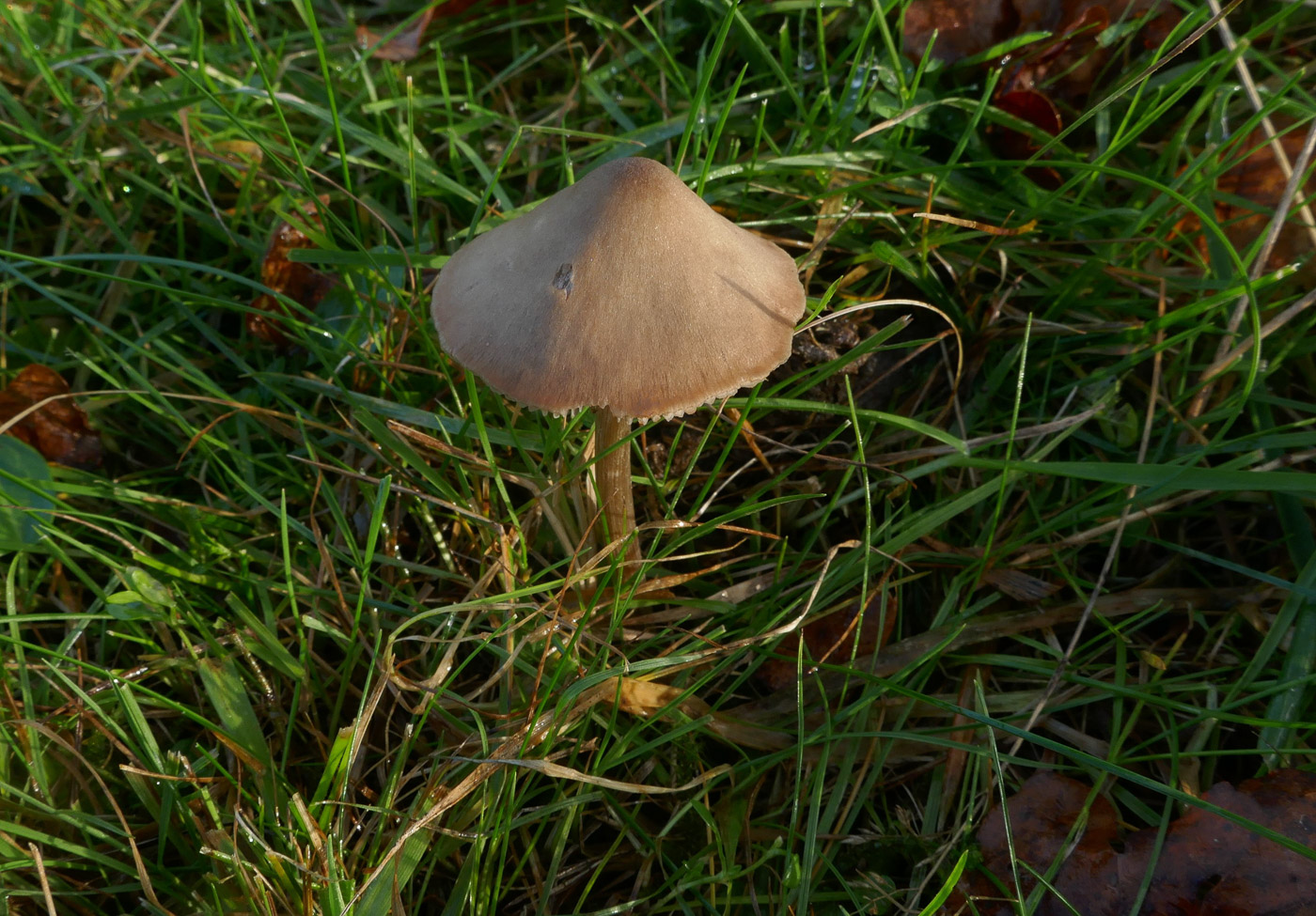
 |
Dec 14, 2024. |
 |
May 1, 2024. |

 |
Jan 4, 2022. |
 |
Oct 30, 2020. |
| Entoloma cf. asprellum (Roughened Pinkgill) | |

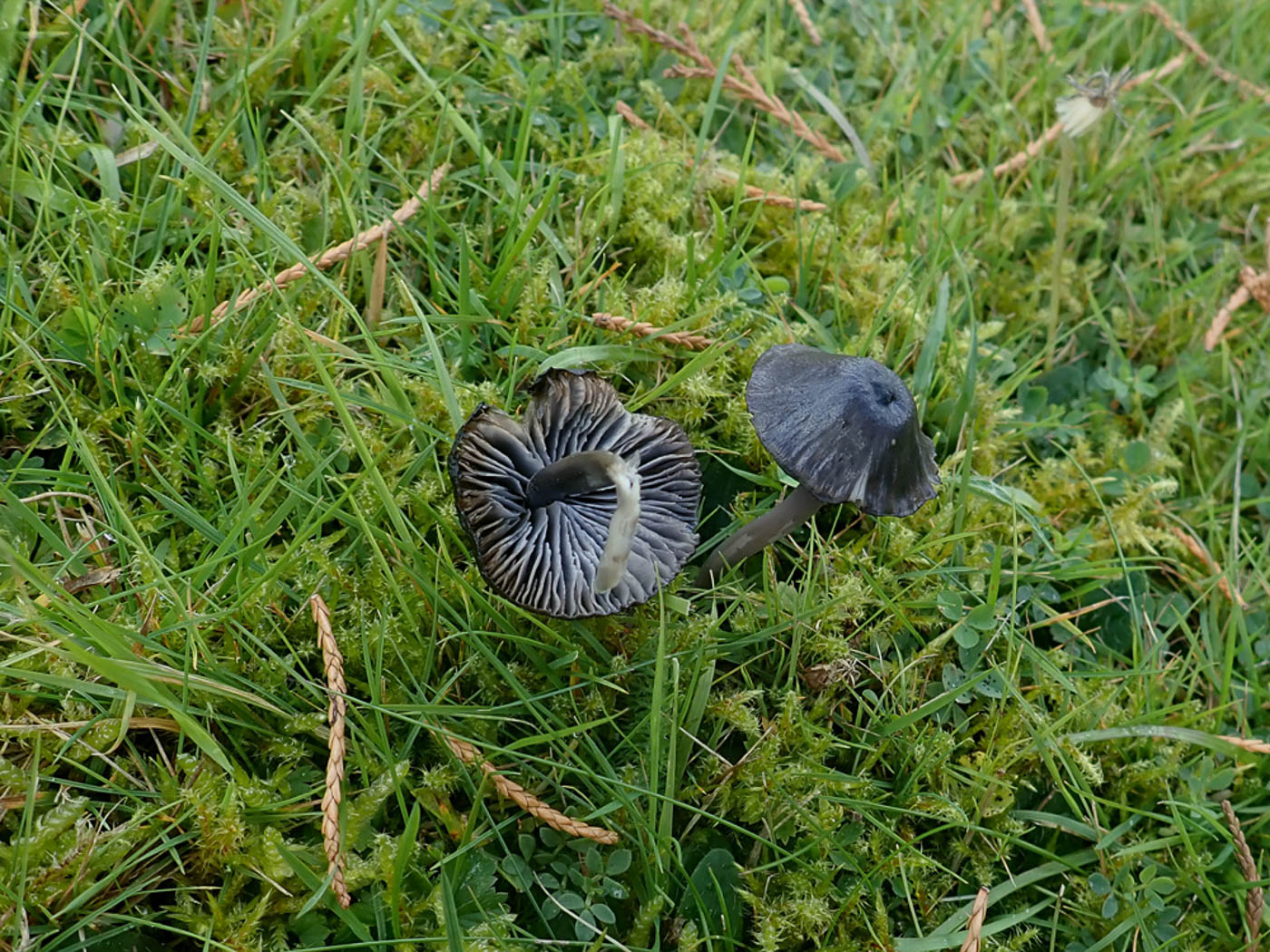

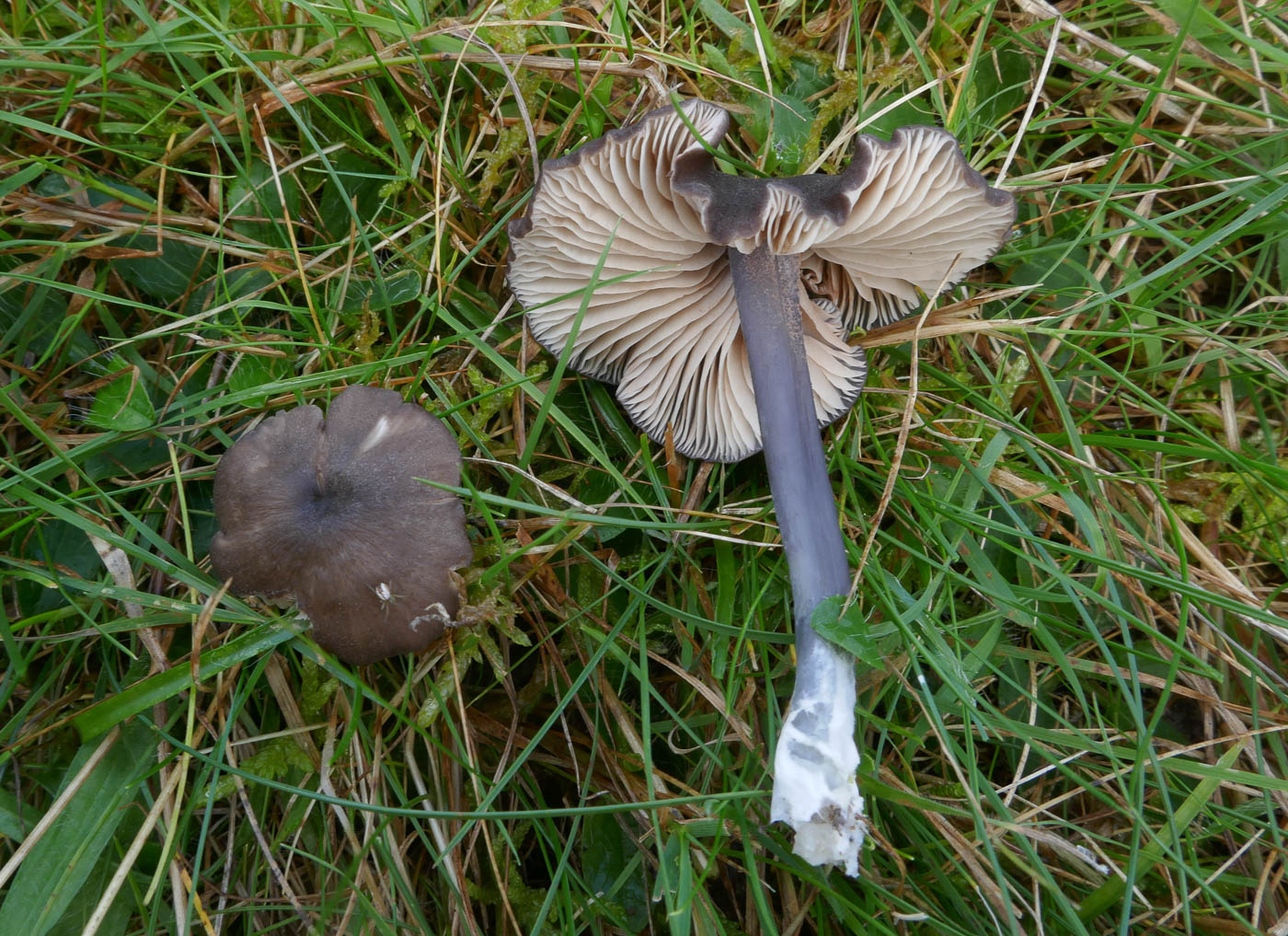
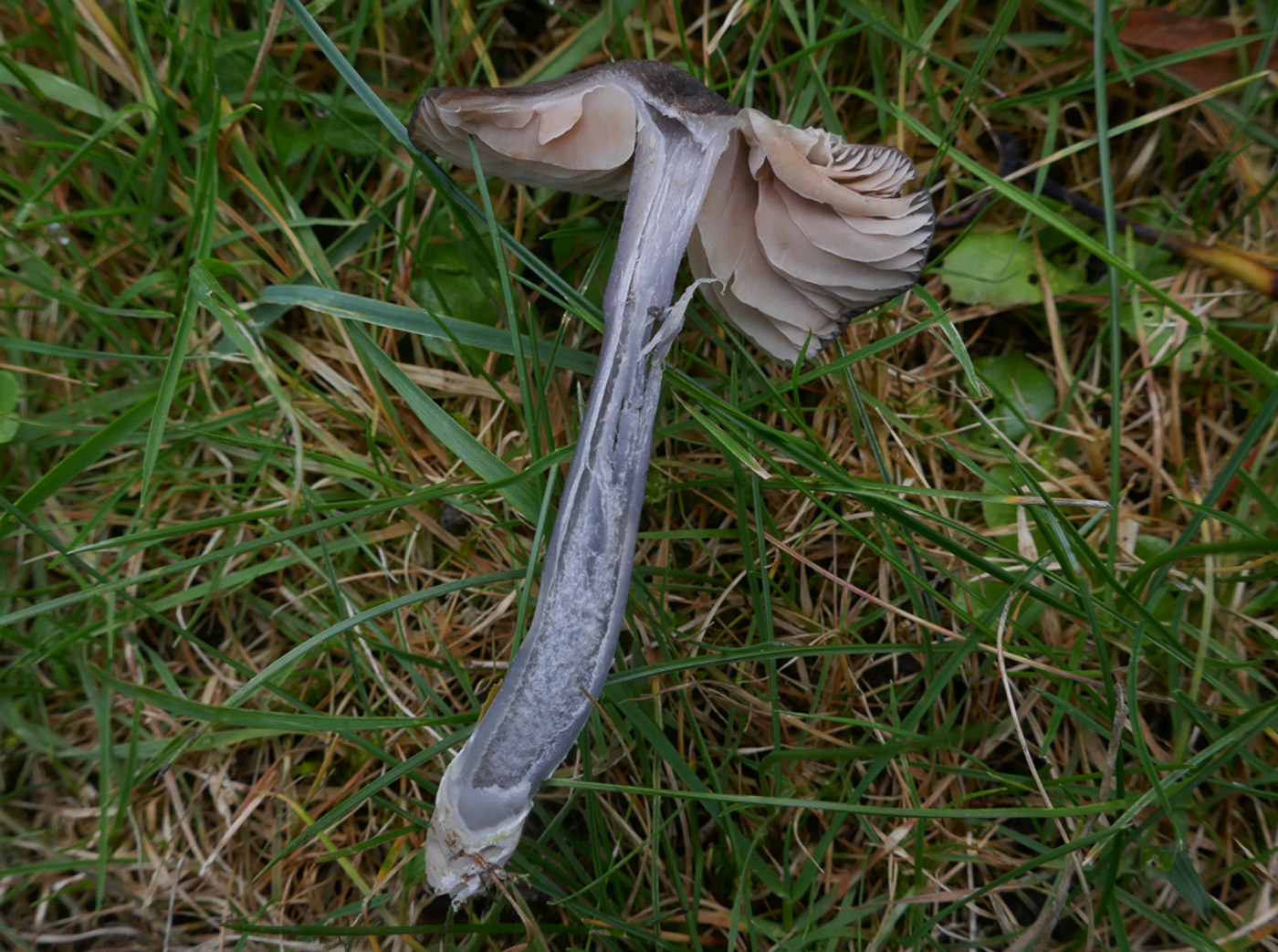 |
Oct 7, 2024. |
| Entoloma exile (Glaucous Pinkgill) | |




|
Oct 10, 2023. |
| Entoloma graphitipes (a Pinkgill with no English name) | |

 |
Dec 2, 2020. |
| Entoloma griseocyaneum (Felted Pinkgill) | |
 |
Nov 3, 2023. In Chalfont St. Peter in lawns Jesper Launder found this Entoloma. Clearly belonging to Section Leptonia owing to the stem showing some blue tints, he attempted to key it out, ending up near to the rare E. glaucobasis, a species having a brown cap and blue lower stem, but was unsure. The sample was therefore sent for sequencing which showed it a match not for that species as he'd hoped but for the similar E. griseocyaneum though as can be seen from his photo compared to our previous finds of this species the cap is rather darker and less obviously felted than one might expect. Still a nice find, however, as we have few county records. |

 |
Aug 1, 2023. In a grassy area in Jordans village Jesper Launder came across this collection of quite a distinctive grassland Pinkgill. The species has a mid-brown cap with a roughened surface and a grey-blue silvery stem but as with all this genus a check of the microcharacters is needed to confirm its ID. Though not considered a rare species, we have just two previous records, both from Coombe Hill, the first in Finds: 2021 Jul 13th. Photo 2 is of a further collection made two days later at Stampwell Farm by Jackie Ewan. |


 |
Jul 13, 2021. In thick grass at Coombe Hill Penny found a couple of collections of an Entoloma which needed work at home to identify - almost always the case with this genus. It did, however, have a distinctive cap with an almost powdered look to it which on close inspection revealed scales which became increasingly smaller from the centre outwards. Furthermore, the stem had a silvery violaceous glint, and these features together with the microscopic details led her to the name. Though not uncommon nationally, this appears to be new to the county perhaps reflecting that local mycologists tend to look less closely at grassland this early in the season. |
| Entoloma hebes (Pimple Pinkgill) | |
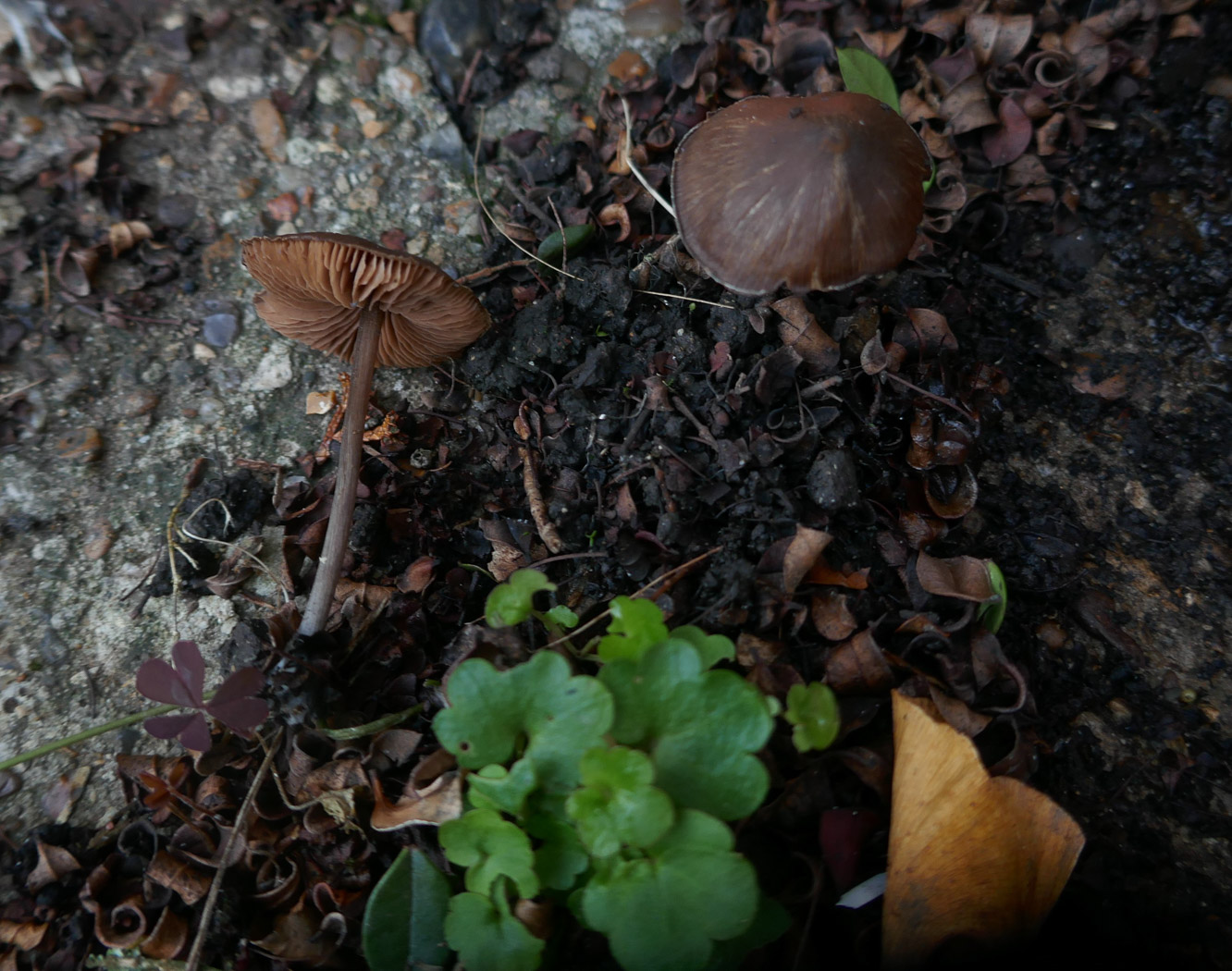
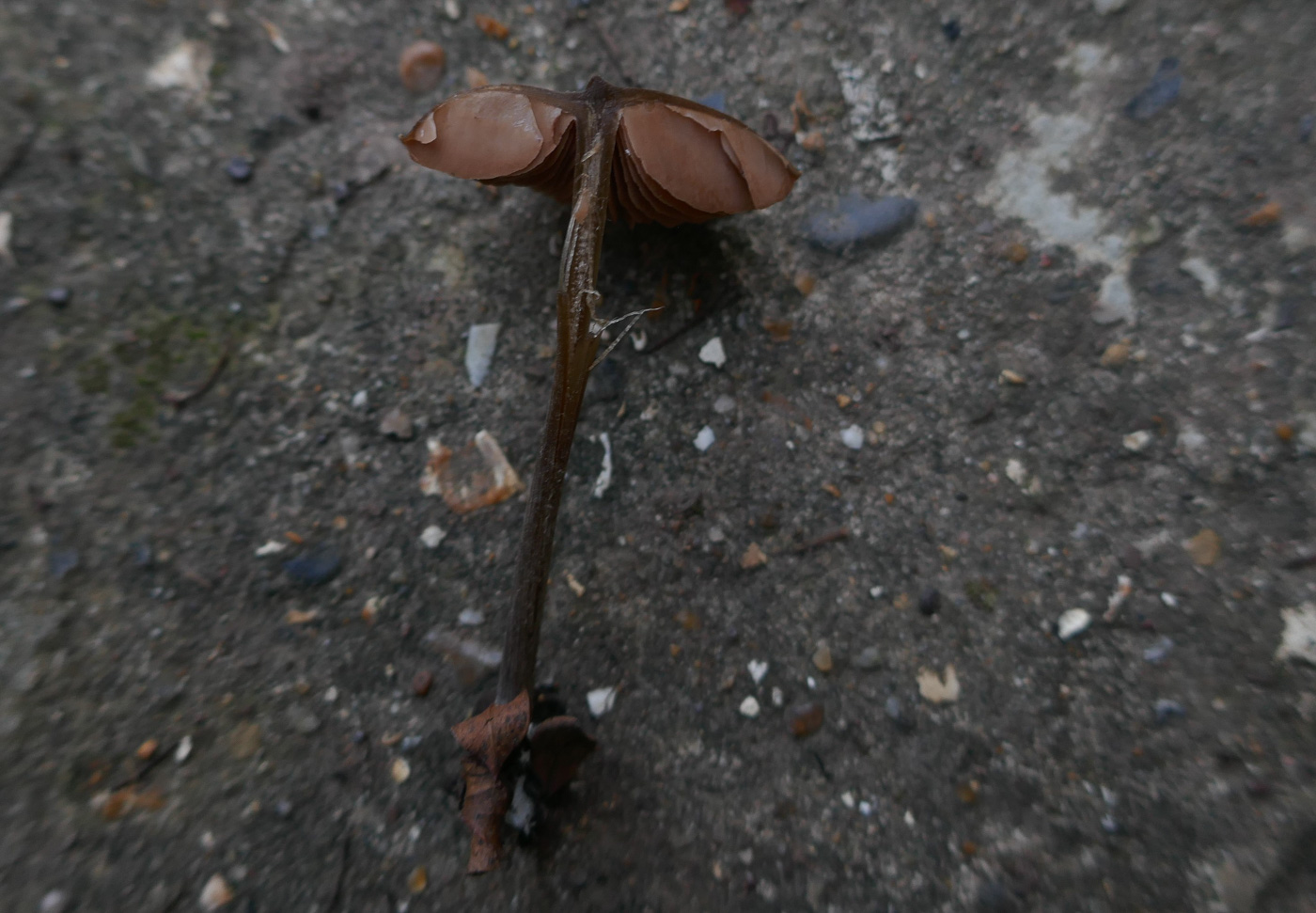
|
Jan 2, 2025. |

 |
Aug 15, 2021. |
 |
Nov 2, 2020. |
| Entoloma hirtipes (Graceful Pinkgill) | |

 |
Apr 28, 2023. |
 |
Dec 20, 2021. |
| Entoloma incanum (Mousepee Pinkgill) | |
 |
Oct 12, 2022. In a grassy area at Dancersend Lisa Dodd found this small but very distinctive Pinkgill which is instantly recognisable in the field on two counts: the unusual greenish tints in the cap and stem, also its extraordinary smell which reminds of a mouse's cage which needs cleaning out! The smell was only faint today, but the green stem which bruises turquoise when handled left us in no doubt as to its identity. This is one of extremely few Pinkgills safely nameable without the need for a scope. (The photo is Barry Webb's.) |
 |
Oct 25, 2020. Penny C. was please to find good numbers of this interesting little mushroom in unimproved grassland at Ragpits Nature Reserve. Nearly all Pinkgills need a scope to identify to species (and even then they are often very tricky), so it's always a delight to come across one which leaves one in no doubt for the name. An uncommon grassland species, it has several redeeming features: the unique green cap colour is enough on its own, but the stem stains turquoise once handled and furthermore it has a strong smell of mouse pee! If you kept mice in a cage as a child, this is precisely the smell which reminded you that the cage needed cleaning out! |
| Entoloma lampropus (Azureleg Pinkgill) | |


 |
Aug 19, 2023. In a grassy path at Stampwell Farm Jackie Ewan found this rare small bluish tinged Pinkgill and recognised it, being near to where she found it last year when it was new to the county confirmed with sequencing. See Penny comments below about the species in that Finds entry: |



 |
Oct 29, 2022. At Stampwell Farm Jackie Ewan has been on the lookout for the many attractive small Entoloma species which have blue colours either on the cap, the gills or the stem - sometimes on all three - to start fruiting. This is the first of them she's found this autumn and happens to be a new species for the county. A rare grassland species - sometimes occurring in forests as well - it has a bright blue fibrillose stem but a brown fibrillose cap which is not translucent, also pale gills with no blue edge which turn pinkish as they mature - one of the diagnostic characters of this large and difficult genus. The collection has been confirmed with DNA sequencing and the material will be sent to the Kew Fungarium. |
| Entoloma pleopodium (Aromatic Pinkgill) | |
 |
Oct 23, 2023. |
| Entoloma porphyrophaeum (Lilac Pinkgill) | |
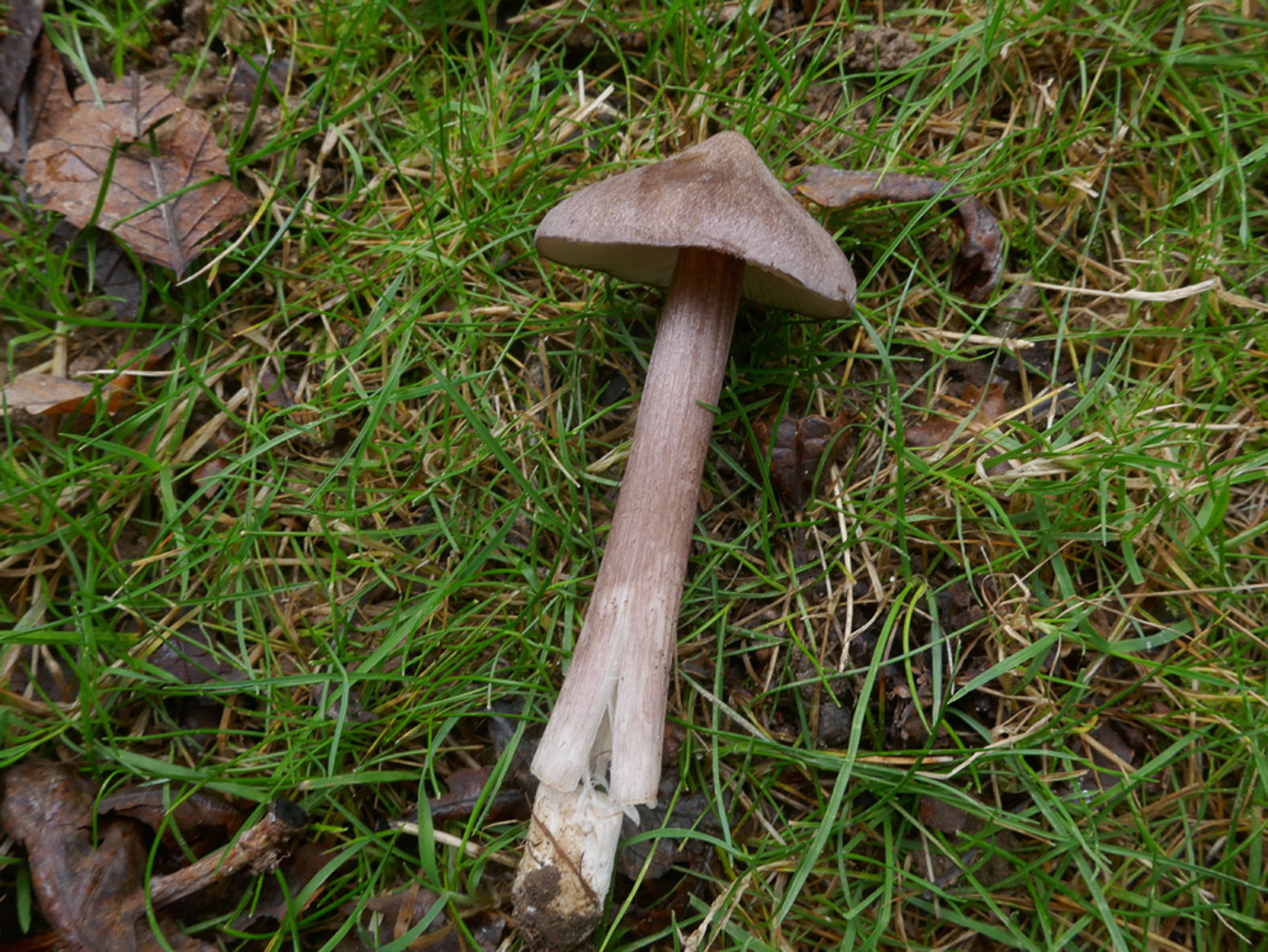
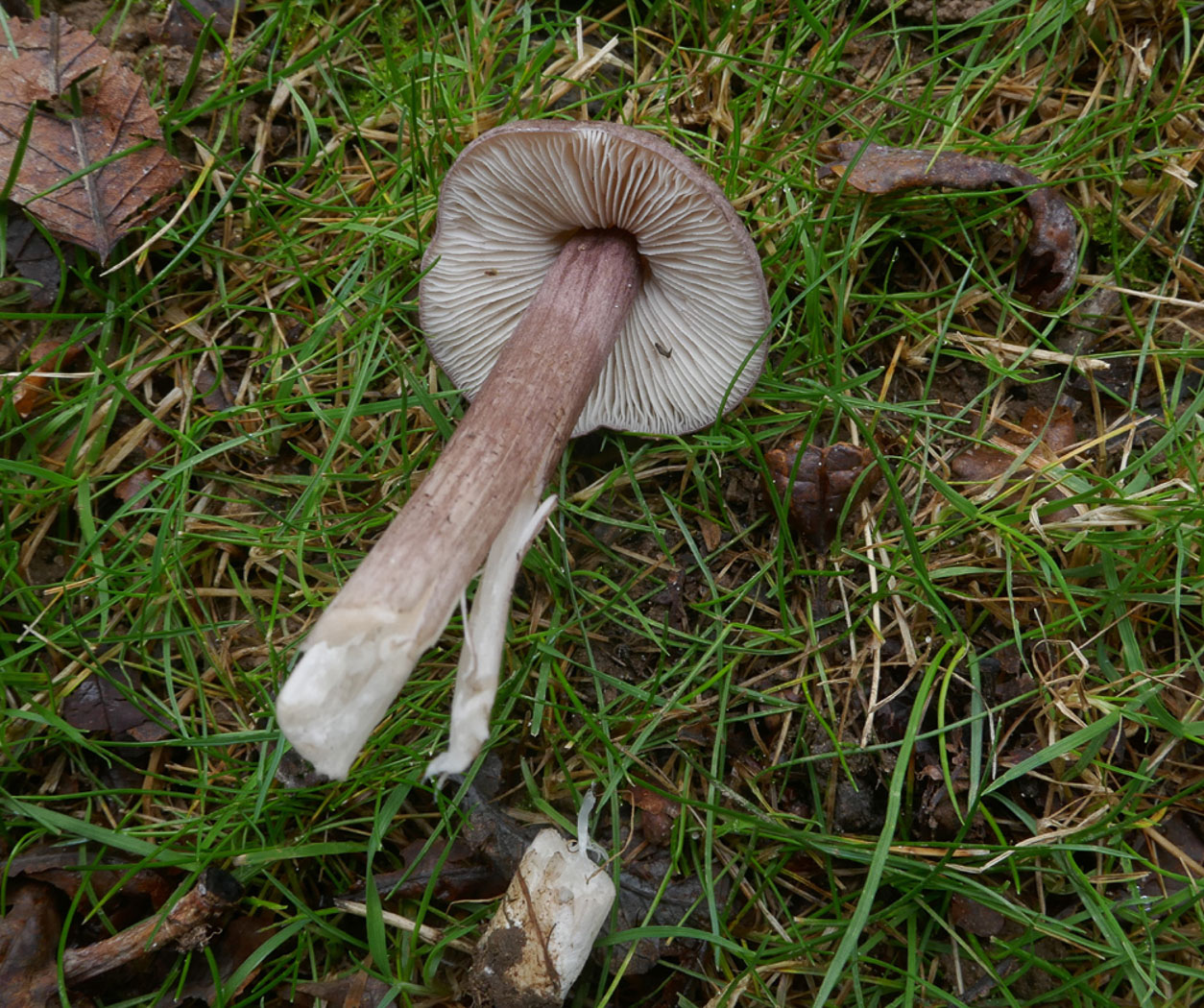 |
Oct 10, 2024. |
| Entoloma prunuloides (Mealy Pinkgill) | |
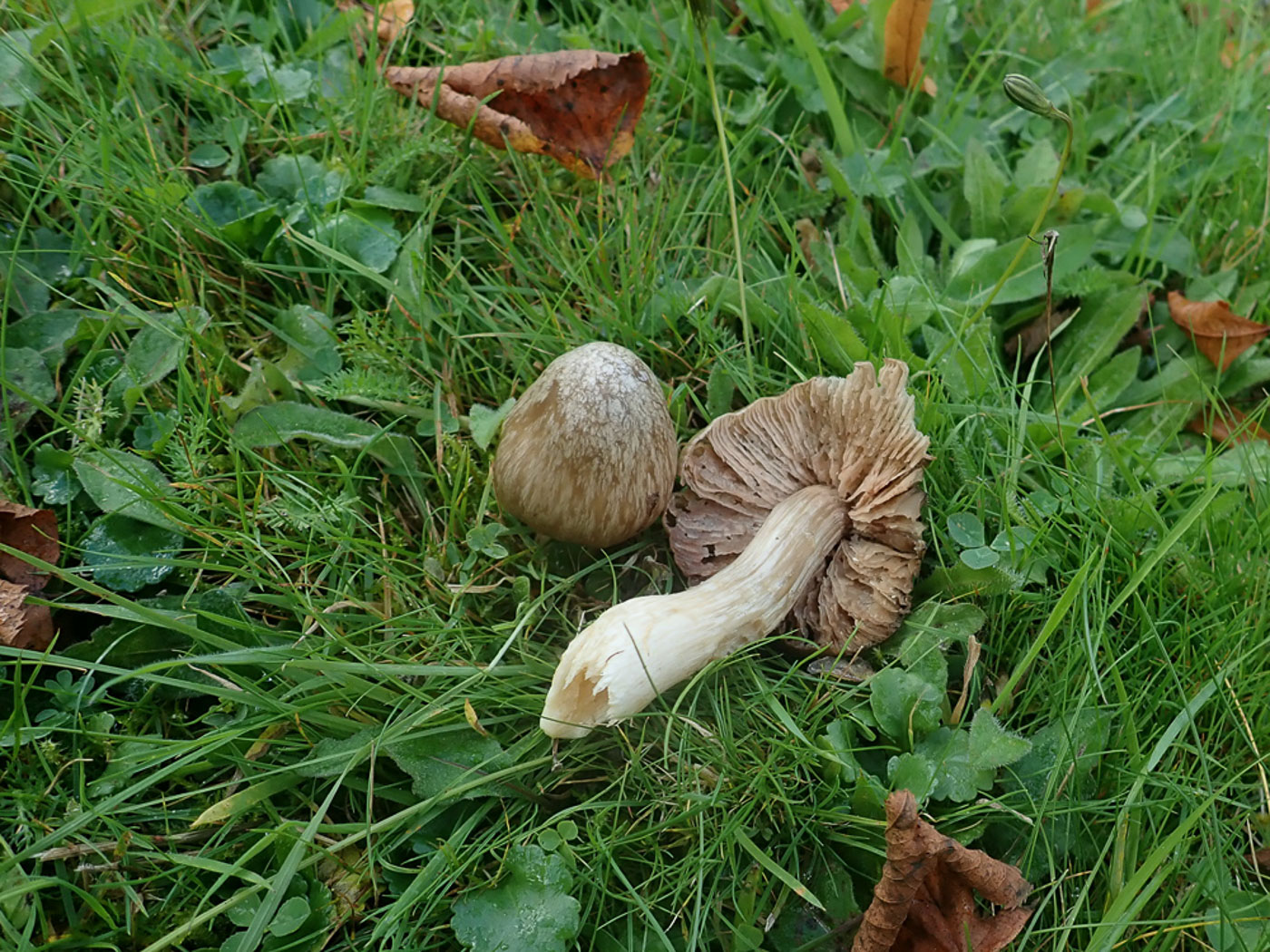 |
Oct 7, 2024. Having received a photo of this species just taken at Prestwood Churchyard by a non-member wanting to know what it was, Penny decided to visit herself and was suitably rewarded, finding not only this same specimen but a load of other interesting species as well. This is quite a distinctive Pinkgill with thick flesh and stem and a distinct smell of meal - quite often found in this genus. She'd found it here last year which also helped though we have only a handful of other known grassland sites for it but it is by no means rare. |

 |
Oct 17, 2023. In lawn at Prestwood Churchyard Penny found a couple of examples of this chunky Pinkgill which, though not that common, is one that can fairly safely be recognised in the field by its fibrillose pale greyish cap and strong mealy smell. It was not until she upturned the large specimen to observe the gills that she found two more small caps emerging underneath (photo 2). The gills are not yet pink here despite its size and clearly it had not yet dropped any mature spores to colour the caps beneath. Note the pink stem base seen here - not a feature of the species but obviously an infection of some sort. By the next morning the entire stem base was covered in white mould - presumably a species of Hyphomycete. See also in Finds 2021 October 30th - Penny's first collection at this site. |

 |
Oct 30, 2021. In Prestwood Churchyard Penny found this singleton Pinkgill which looked quite distinctive but was unfamiliar. Quite chunky in stature for this genus, the cap was streaky fibrillose, the gills were crowded but with a crenulate edge and it had a farinaceous smell. Not being a fan of this genus, Penny asked Derek to take a look at it for her, which he kindly did! Though not a rare species we have only one previous record from Coombe Hill back in 2000. |
| Entoloma rhodopolium (Wood Pinkgill) | |
 |
Oct 16, 2020. |
| Entoloma sericellum (Cream Pinkgill) | |
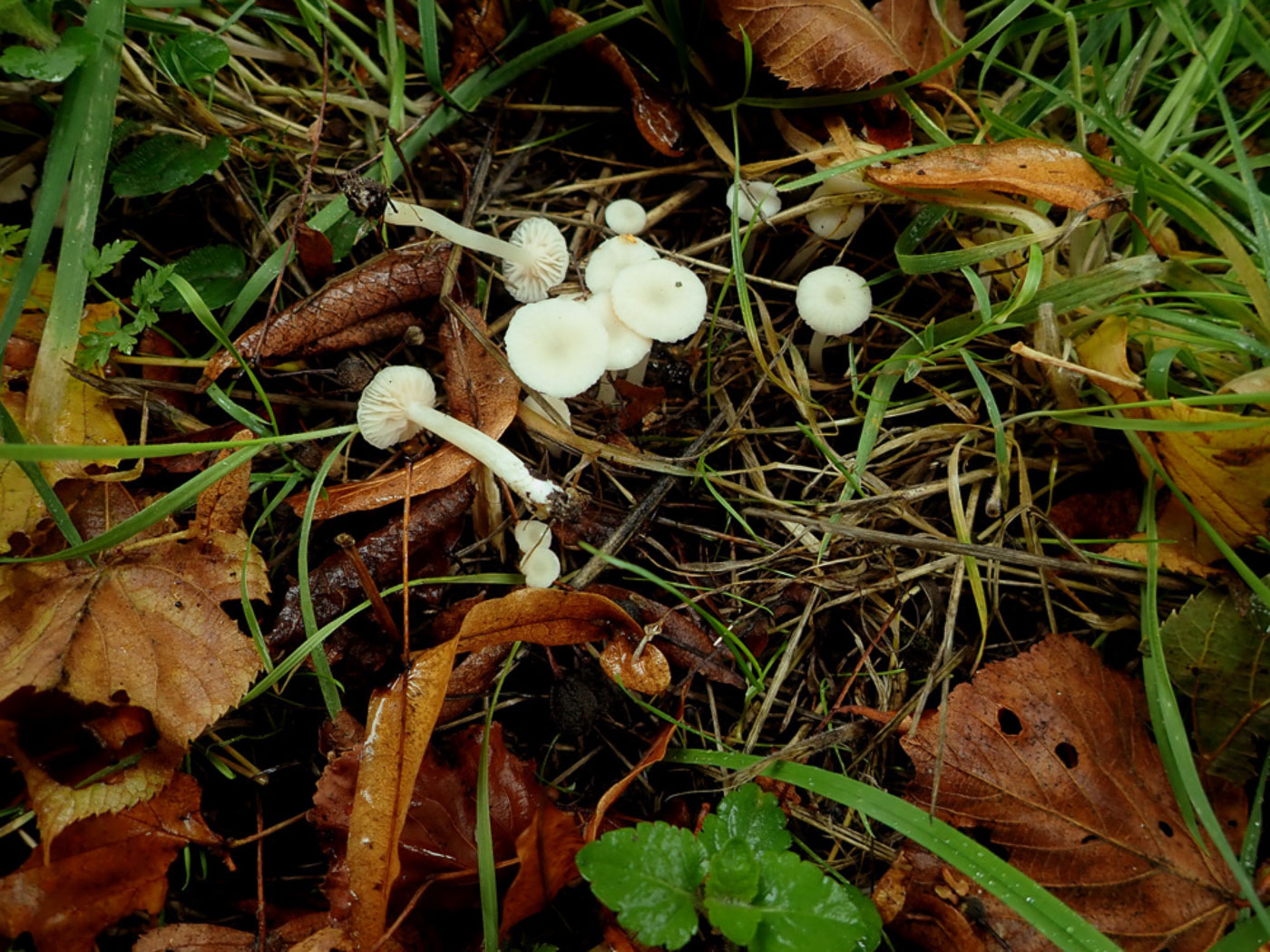 |
Sep 17, 2025. |
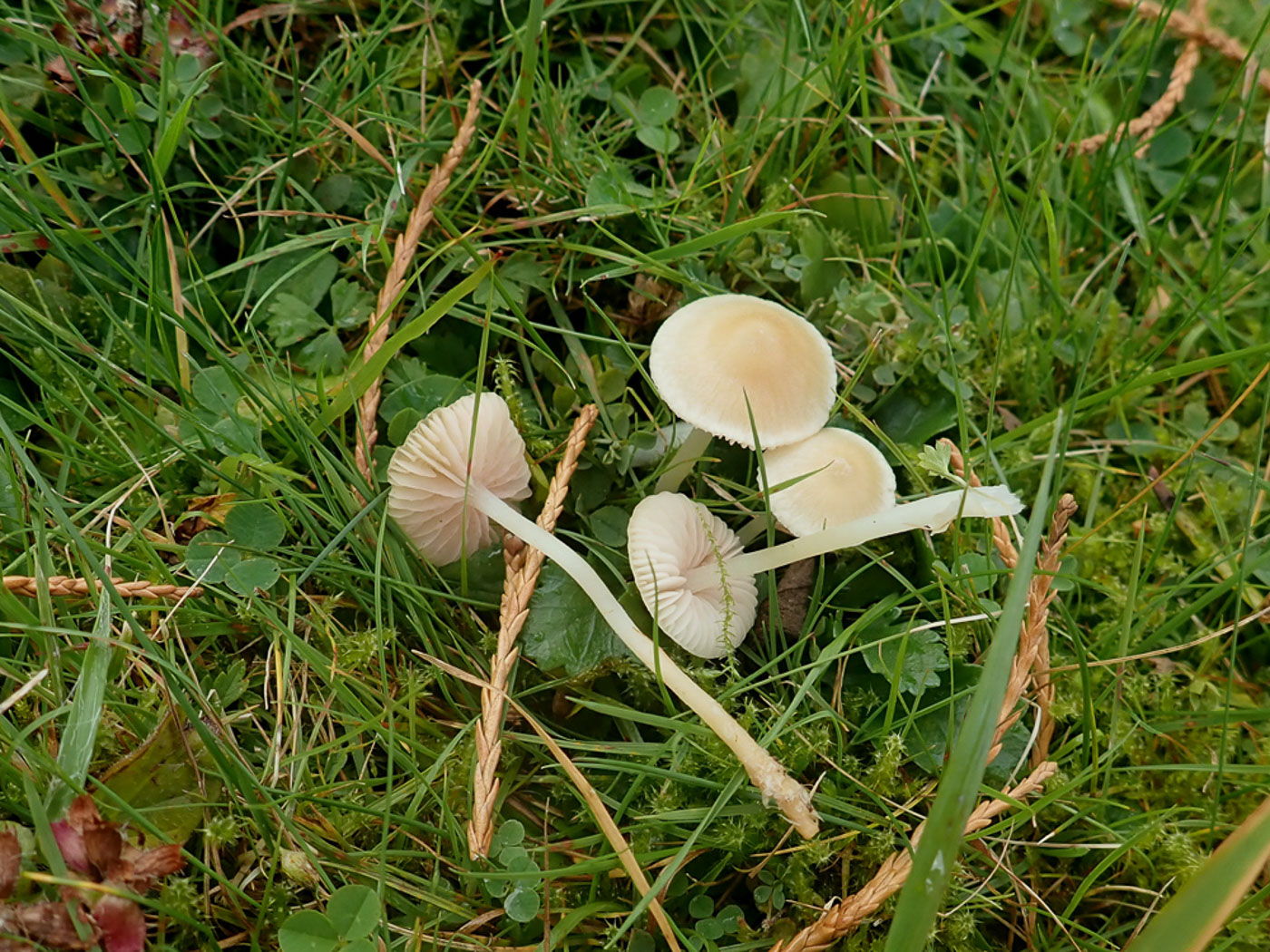
 |
Oct 7, 2024. At Prestwood Churchyard Penny found good numbers of this pale Pinkgill coming up in the short mossy grass. Not being a particular fan of the genus she was unsure of the species but as it was fruiting so prolifically she was keen to determine it. Though many online images of the species show a pure white mushroom, she learnt that this is not necessarily the case (as the English name reflects) and it may be that many white Pinkgills are named E. sericellum in error. Anyway the micro-details and general description fitted this collection well. Surprisingly though we have many county records (which I now have some doubts about!) this has not been recorded here before. |
 |
Jul 30, 2023. Along the grassy verge in the Lime avenue at Turville Heath Penny found this little collection of a whitish-capped Pinkgill. This is the commonest of several white Pinkgills - quite a common species grassy woodland glades and needing a scope to check microscopic details. |

 |
Sep 27, 2022. In the litter in the avenue of Limes at Turville Heath Penny noticed this group of small pale-capped mushrooms which had distinctly pink gills. At home the genus was confirmed by the spore shape - unique to Entoloma - and other microscopic features also confirmed the species, one of several having white to cream caps. Not rare, it can be found in grassland as well as woodland and this is its first entry for Finds. Photo 2 is of another collection found by Jackie Ewan at Stampwell Farm the day before Penny's. The number of times that happens .............. |
| Entoloma sericeum (Silky Pinkgill) | |
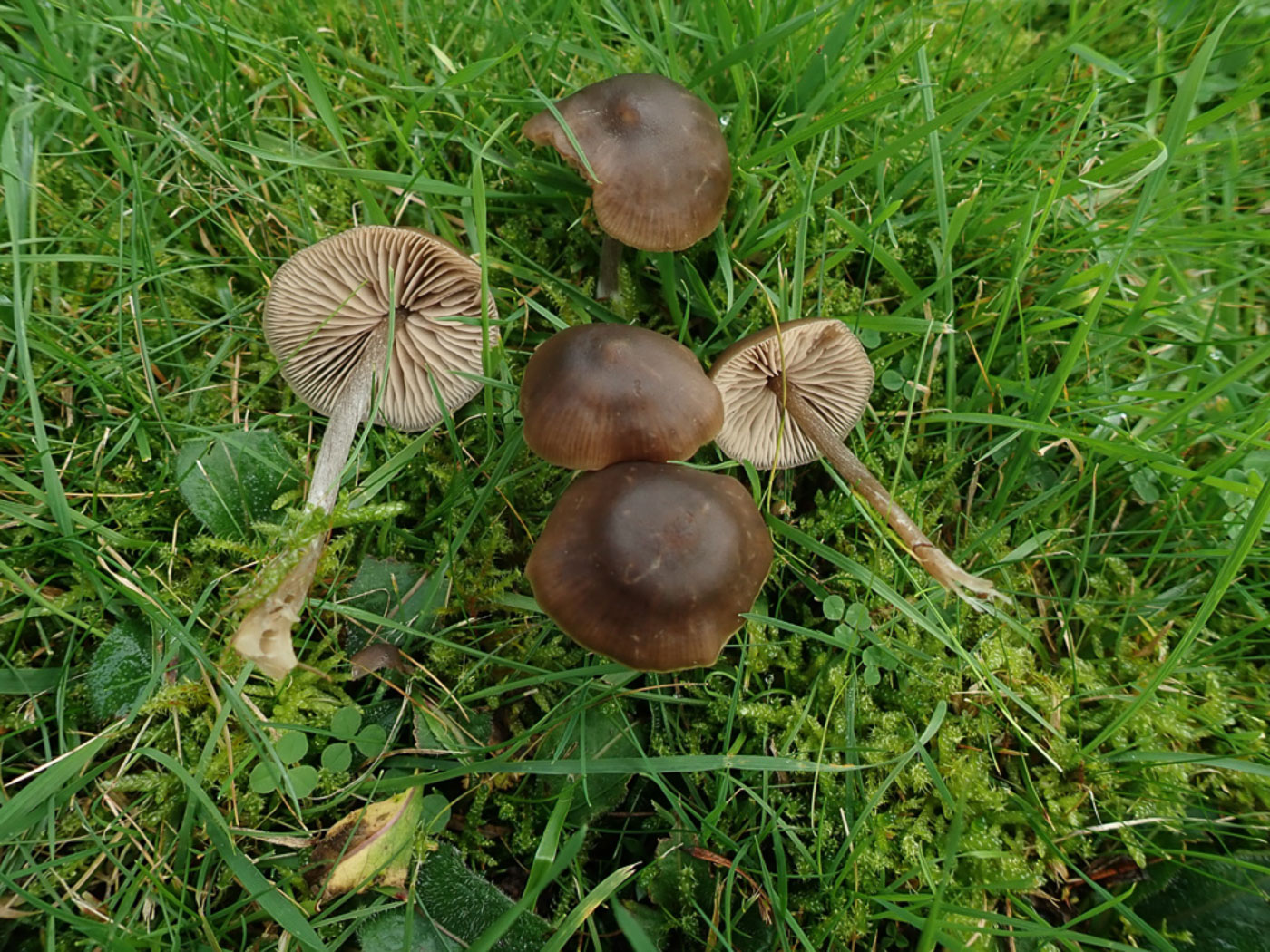 |
Nov 13, 2025. |
 |
Oct 10, 2020. |
| Entoloma serrulatum (Blue-edge Pinkgill) | |
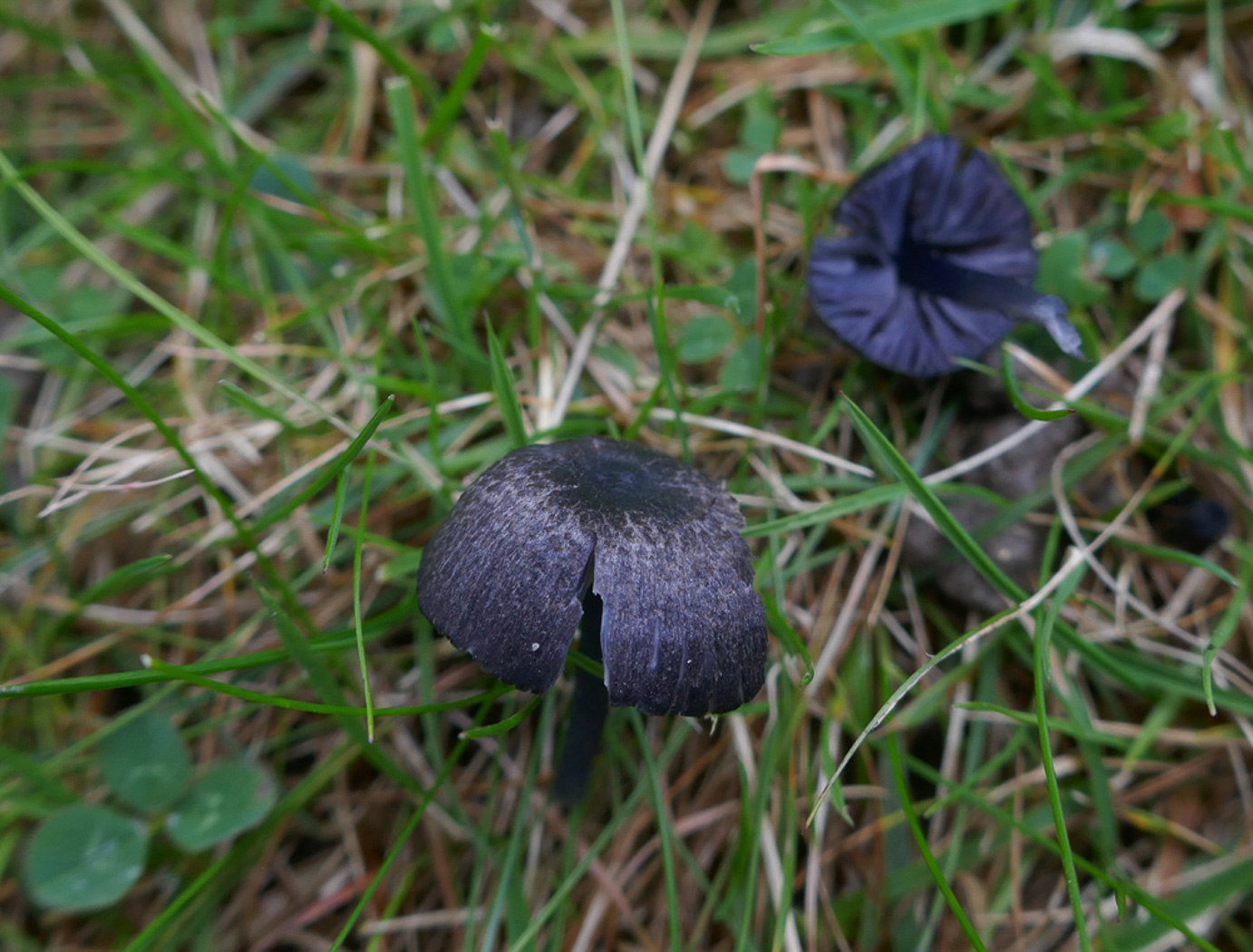
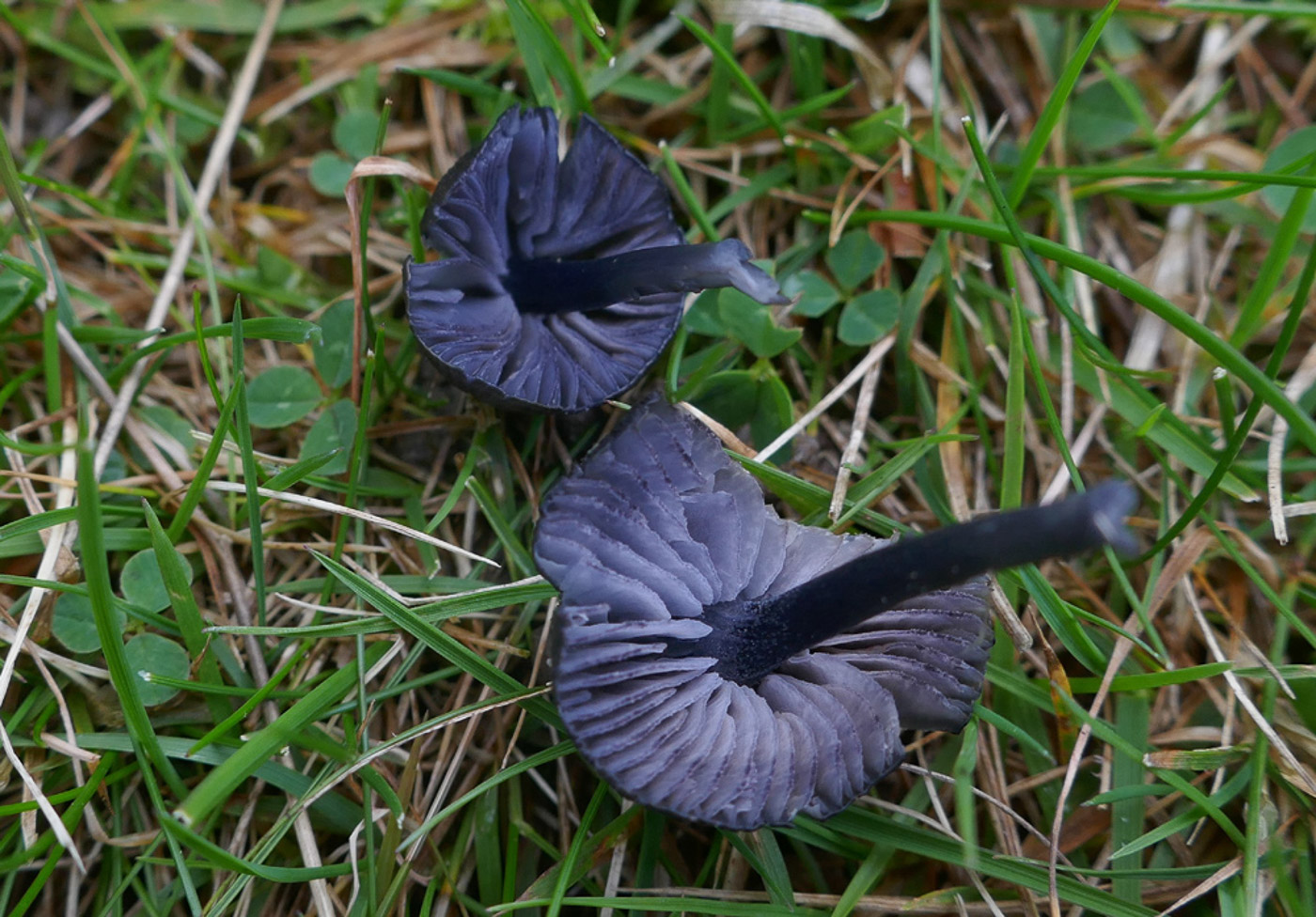 |
Oct 8, 2024. At Stampwell Farm Jackie Ewan found this species together with some other Pinkgills in a heathy grassy area. It is one of the small blue Pinkgills (placed in Section Leptonia) which have a blue edge to the gills and also has a roughened cap surface. Though apparently one of the commonest of this group of species, we do not have that many county records. |


 |
Aug 15, 2021. In soil in grass at Prestwood Churchyard Penny found a few small dark blue caps and turning one over noticed that this colour was also faintly lining the edge of some of the gills. Pinkgills - a huge and tricky genus - mostly have brown caps, but those having blue caps or stems (or both) belong in Section Leptonia which at least then reduces the number of species to a more manageable number when trying to key a collection out. Even fewer from this section have a blue gill edge making the task even less arduous, and today's species is possibly the commonest of those (though none are that common!). We have just four previous county records from three sites. For comparison see also E. chalybeum v. lazulinum dated July 12th and E. pseudocoelestinum dated Aug 14th. |
| Entoloma sp (an unidentified Pinkgill) | |
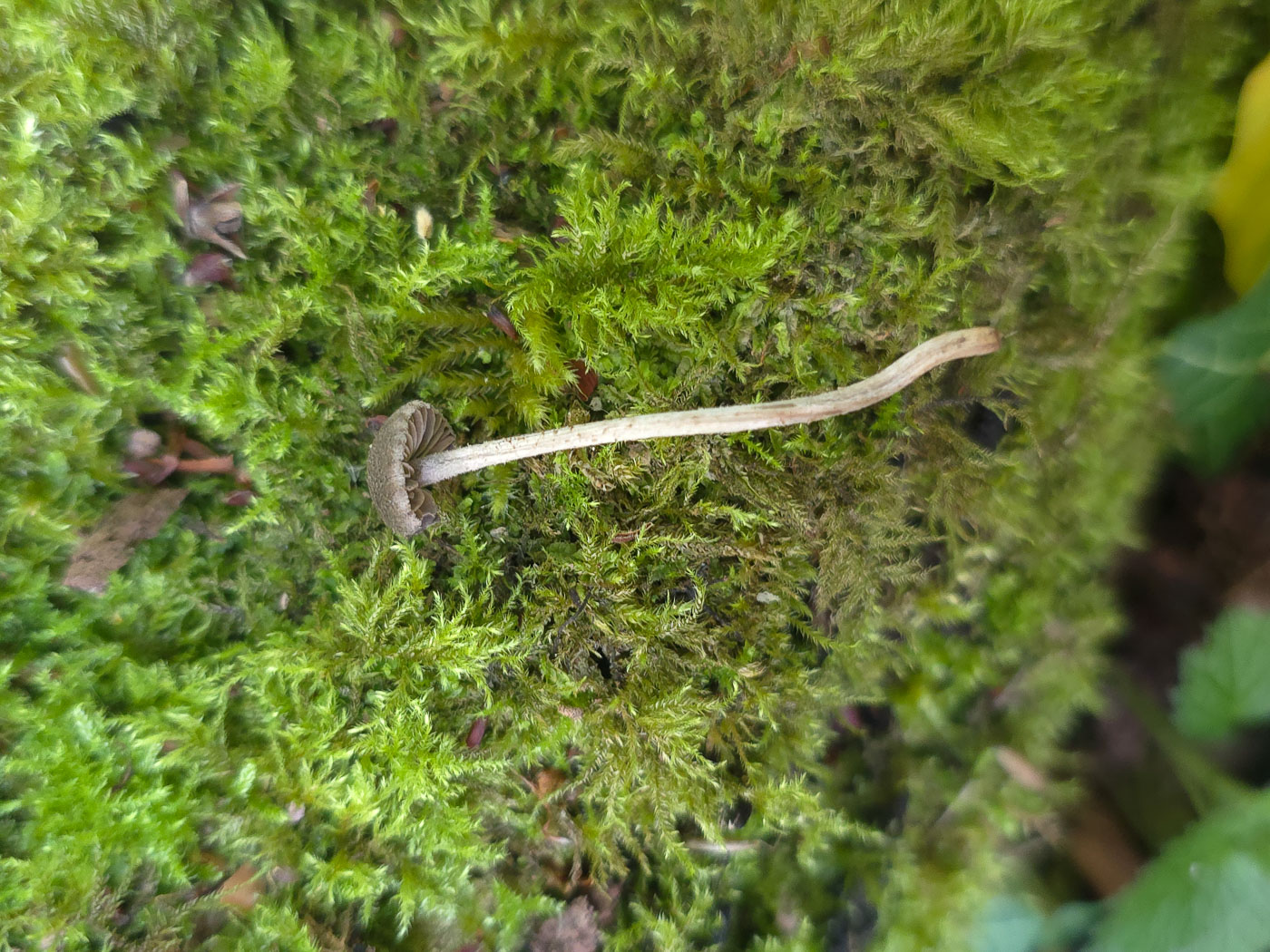
 |
Sep 21, 2025. |
| Entoloma undatum (Zoned Pinkgill) | |

 |
Aug 9, 2023. |
| Entoloma ventricosum (Ventricose Pinkgill) | |



 |
Mar 21, 2024. |
| Entyloma ficariae (Lesser Celandine Smut) | |

 |
Mar 30, 2024. At Turville Heath Penny found the Lime avenue understory covered in Lesser Celandine and it was not long before she noticed the telltale pale angular patches on many leaves made by this species of host specific smut. It is very common in spring but appears to do no permanent damage to the plant. |

 |
Apr 18, 2023. At Burnham Beeches Penny was not surprised to see huge patches of Lesser Celandine leaves covered in the white patches caused by this fungus - there was hardly a leaf unaffected in some areas. Photo 2 shows the underside of a leaf. The fungus seems to have no adverse effect on the plant to which is it host specific. This is a new entry for Finds. |
| Epichloe clarkii (an Ascomycete with no English name) | |
 |
Jun 30, 2023. In Gerrards Cross Jesper Launder noticed this rustlike fungus surrounding the stem of a living grass, Creeping Soft-Brome. This is new to the county and there appear to be only 20 records on FRDBI, though its apparent rarity may possibly be attributed to the lack of recorders who know their grasses and who look for such species at this time of year. |
| Epichloe sylvatica (a species of Choke with no English name) | |
 |
Jul 16, 2023. In Bernwood Forest Jesper Launder noticed this Choke species on the living stem of Brachybodium sylvaticus (Wood False Brome). The genus is a member of the Ascomycetes and forms endophytic symbiotic relationships with the host plant. Though apparently not rare, this species has not previously been recorded in Bucks - you need to know your plants, also when and what to look for to locate these species - and is also another new entry to Finds. |
| Epichloe typhina (Choke) | |
 |
Jul 15, 2021. On a grass stem at Stampwell Farm Jackie Ewan found and identified this summer fruiting species which apparently occurs on many different grasses, starting out white and yellowing as it matures. Though common this is only our second county record reflecting how we tend to focus on woodland autumn season fungi, no doubt overlooking many common things which occur else where at other times of year. |
| Eriopezia caesia (discomycete with no English name) | |
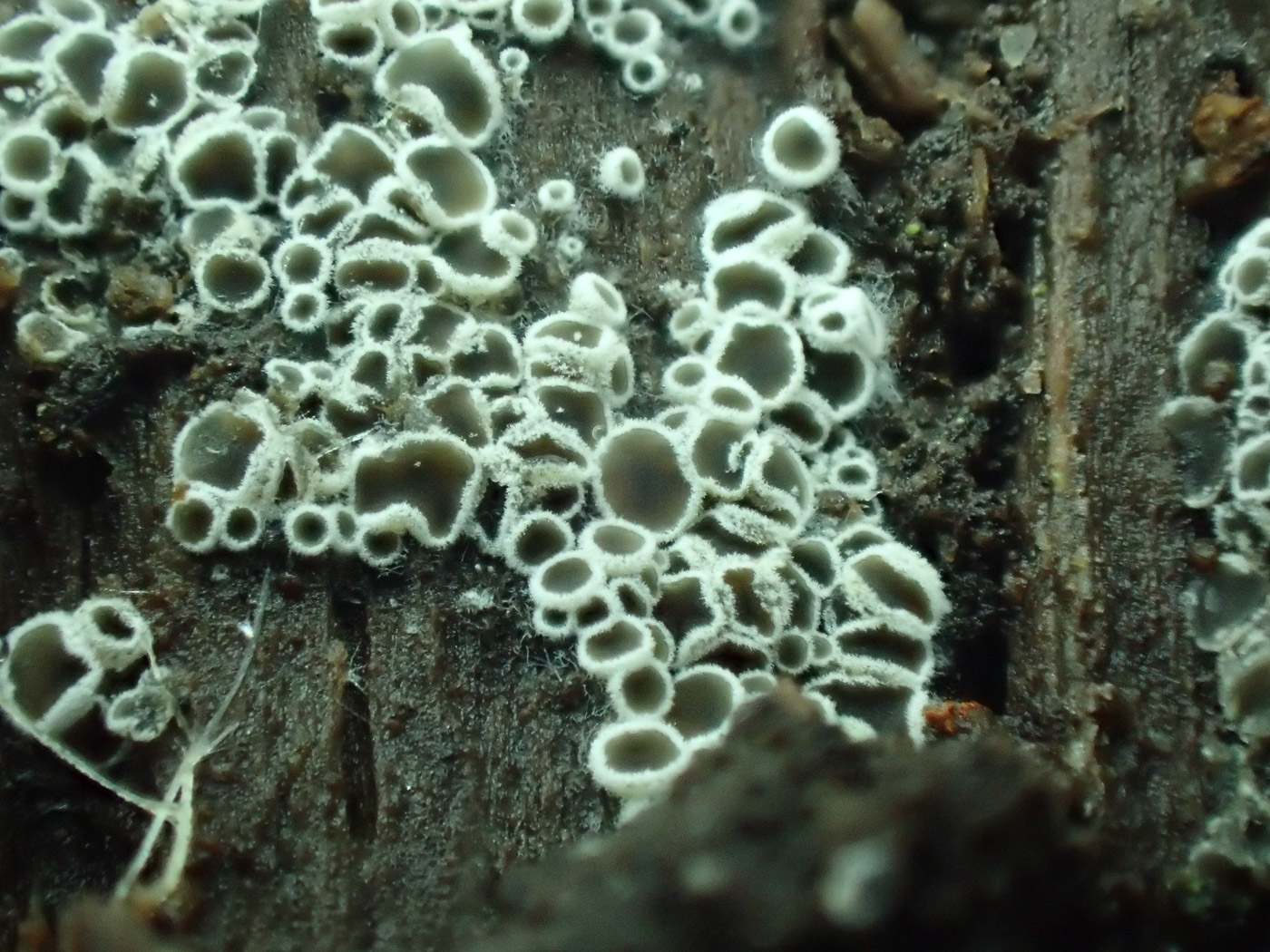 |
Dec 12, 2024. |
| Erysiphe alphitoides (Oak Mildew) | |

 |
Aug 10, 2025. At Burnham Beeches during our microscope workshop Penny struggled to find any fungi worth collecting but saw this nice patch of a very common mildew on a young Oak sapling. (Note in the sunlit background (photo 1) the top of a Wood Ant's nest - a sure sign you're in Burnham Beeches where such nests are huge, commonplace and very active at the moment!) |
 |
Jul 19, 2021. On the living leaves of many Oaks in Burnham Beeches Penny saw this very common mildew seen in summer and autumn. There are many species of this genus and this one can be named purely through it being on Oak leaves though it also can occur on Sweet Chestnut and (very rarely) on Beech as well. |
| Erysiphe heraclei (Umbellifer Mildew) | |
 |
Aug 1, 2021. In his Jordans garden Jesper Launder noticed this very common mildew on Hogweed leaves - an inconspicuous summertime fungus which often goes unnoticed as do many such species on plant foliage. |
| Erysiphe poligoni (a species of mildew with no English name) | |
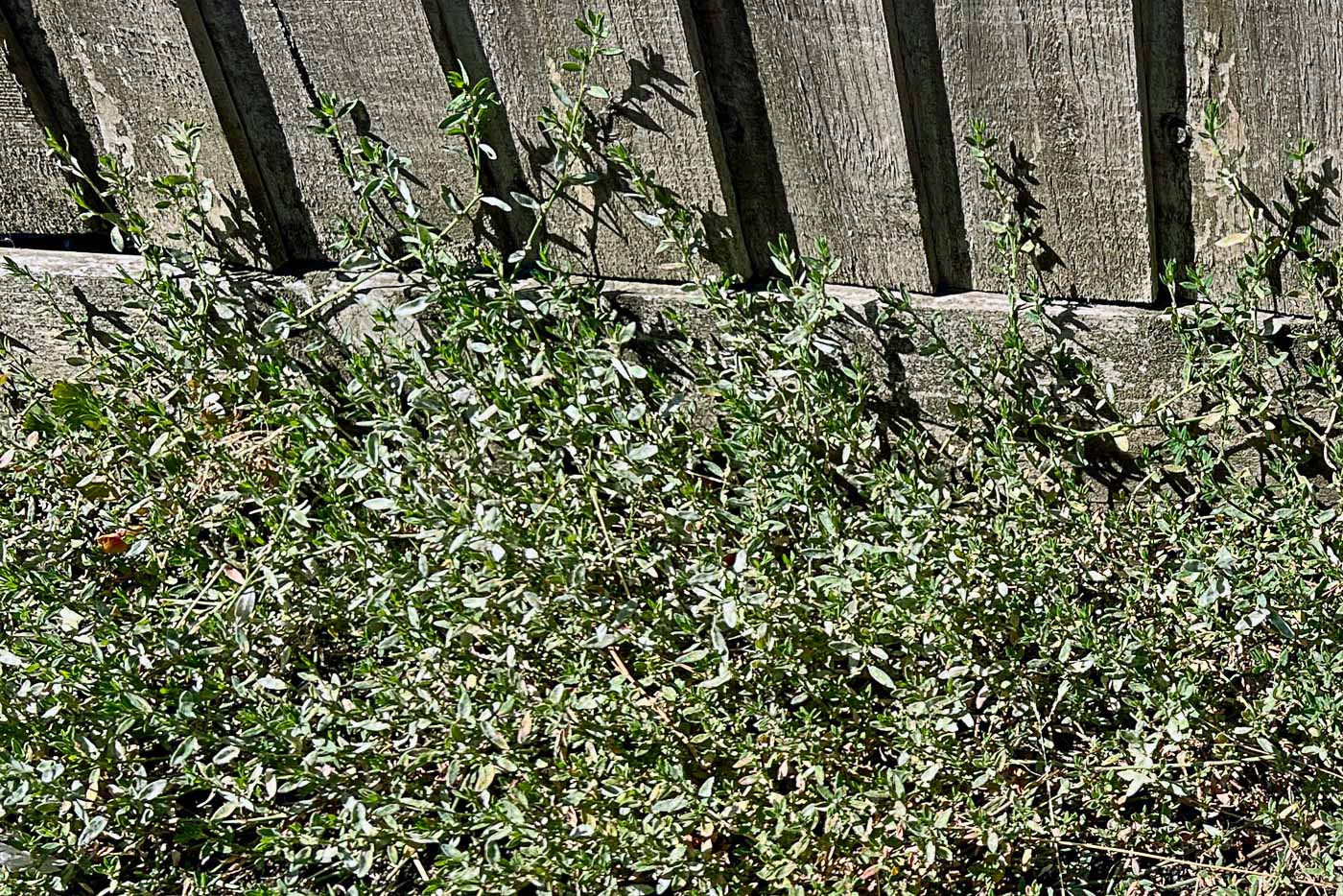
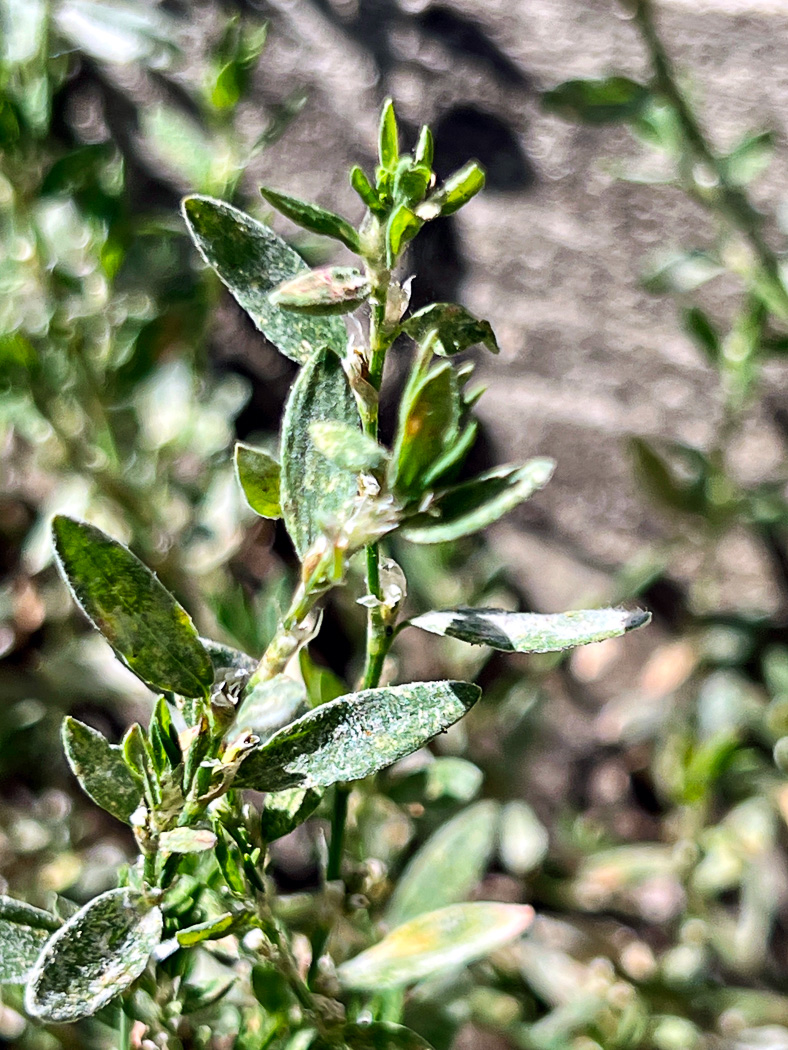 |
Aug 24, 2025. In Walter's Ash Neil Fletcher - always on the lookout for unusual species affecting plants - noticed this large patch of Knotgrass (Polygonum aviculare) which was covered in this powdery mildew. He found in his Ellis & Ellis that this was the only likely mildew to be affecting this particular plant so has made the assumption - without having recourse to a scope - that his ID correct. We have just four previous county records, the latest over 10 years ago and before that all in the previous century, so it's good to have a more up-to-date record. New find |
| Exidia glandulosa (Witch's Butter) | |

 |
Nov 23, 2025. In the avenue of Limes at Turville Heath Penny noticed a piece of fallen wood with a good supply of this jelly fungus no doubt recently refreshed by yesterday's rain. This is a genus which shrivels up to virtually nothing in dry weather but will recover its jelly texture as soon as sufficient rain is able to be reabsorbed. This was typical material with photo 2 showing the finely bumpy under-surface (on the left) in contrast to the smooth undulations of the upper surface. |
 |
Mar 30, 2024. At Turville Heath Penny found this well irrigated collection of jelly fungus after the recent rains. This genus quickly shrivels in dry weather but then can swell and become gelatinised when it rains, so is thriving this spring! Note the finely bobbly surface on the underside visible here, a feature which helps to eliminate other similar members of At Turville Heath Penny found this well irrigated collection of jelly fungus after the recent rains. This genus quickly shrivels in dry weather but then can swell and become gelatinised when it rains, so is thriving this spring! Note the finely bobbly surface on the underside visible here, a feature which helps to eliminate other similar members of Exidia in the field. in the field. |


 |
Jan 24, 2024. In Austenwood Common (nr Chalfont St. Peter) Jim Wills came across this Jelly Fungus on fallen bare deciduous wood. There being two very similar black species, he took it home and checked the spore size which confirmed his initial field ID. Both E. glandulosa and E. nigricans (previously plana) have the same slightly bumpy uneven 'warty' undersurface visible in places in both photos 2 and 3. E. glandulosa forms loose cushion-like structures (seen here) rather than the smaller more wrinkled 'brain-like' structures of E. plana (Warlock's Butter). NB Do not confuse either species with Bulgaria inquinans - similarly black and jelly-like but not in any way related) which leaves a black deposit on a finger when rubbed - not the case with Exidia. |

 |
Mar 19, 2022. In Turville Heath Penny found several examples of this jelly fungus on fallen Lime, noted the cushionlike shape and bumpy undersurface, then later checked a few spores to confirm. Compare with E. nigricans, entered two days ago. |

 |
Jan 1, 2022. On fallen Lime branches at Turville Heath Penny found good numbers of examples of this black jelly-like species. She checked that the black did not stain her finger when the top surface was rubbed - a pointer to the similar but unrelated Bulgaria inquinans which is an Asco rather than a Basidiomycete as here - then noted the finely bumpy undersurface which is a feature of both this species and the very similar E. plana - often confused with it. Then at home the larger spores of this particular species confirmed the determination. |

 |
Feb 9, 2021. Paul Goby found these typical specimens of a fairly common Jelly fungus on fallen deciduous wood in Naphill Common. We also have a photo of this dated Jan 06 but today's photos show the species well, particularly the detail in photo 2 where the tiny 'bobbles' on the undersurface are clearly visible - a good pointer for the species. |
 |
Jan 6, 2021. In Naphill today Paul Goby found these black 'shiny firm wrinkled blobs' - his description! They were growing on a bare dead trunk - likely to be Oak on which this genus is probably most often found though it can occur on other deciduous wood and at any time of year given damp enough conditions. It is another of the 'Jelly fungi' belonging to the Basidiomycetes despite often appearing very similar to the Ascomycete Bulgaria pura. |

 |
Oct 23, 2020. Penny C. found a large fallen Beech trunk liberally covered with this species in Ashridge. A common species on fallen rotting deciduous wood, this is one of our jelly fungi and forms colonies of dark brown to black slightly frilly soft gelatinous blobs. There are other species of Exidia though this is the commonest being this colour. E. nucleata is equally common but is more or less colourless to white and forms smaller smoother blobs. |
| Exidia nigricans (Warlock's Butter) | |



 |
Mar 17, 2023. In Austenwood Common Jim Wills spotted these patches of blackish brainlike jelly fungus on recently felled deciduous wood, then checked the spore size to confirm his ID. Penny's comments on her collection (see Finds 2022 Jan 17th) explain fully the confusing situation around the names of the 'black' Exidia species and how to separate them, but she took a closer look at Jim's photos before including them here because they are clearly not plain black but in places translucent and/or brownish, hence raising some doubts as there are other purely brown species within the genus. However, checking other available images and various texts set her mind at rest: this species is not necessarily entirely black and fuller descriptions include translucence, also brown / grey colours, furthermore the flattish rather shapeless smallish folds are typical whereas other species tend to be more formed and 'turbinate' (cushionlike). If in doubt, checking the spore size is very useful; if on conifer rather than deciduous wood you will have one of the more unusual Exidia species. (The final photo was taken by Bob Simpson in his Salden Wood three days earlier and is in fact more typical.) |


 |
Jan 17, 2022. On a deciduous attached branch in Burnham Beeches Penny found this jelly fungus liberally fruiting and took a piece home to check the spore size. There is a fair amount of confusion regarding the names - both Latin and common - of two very similar species, E. glandulosa and E. plana. Both have been known as Witch's Butter and also confused with each other, but it appears now that what was E. plana is now E. nigricans (as named here) with a different common name also. The two are best separated by spore size (larger in today's species), but in the field E. nigricans forms a rather shapeless wrinkled shiny black brainlike mass, sometimes extending over 12 cms or more as seen here, easily detached from the substrate. E. glandulosa forms smaller patches but of bigger individual black 'cushions' and is more securely attached to the substrate. Both species have a bumpy slightly warty undersurface (seen in photo 3 - apologies for the quality!). Compare with E. glandulosa on Finds 2022 Jan 1st where the larger more shaped cushions can be seen. |
 |
Feb 1, 2021. Joanna Dodsworth noticed this fungus on a piece of old deciduous firewood in her neighbour's store shed in Brill! Naming these almost black species of Exidia can be confusing as there have been various synonymies with the common E. glandulosa (Witches' Butter, see also photo dated Jan 06). However, Joanna dutifully checked the spores of this specimen and found them clearly too large for that species and therefore identified it as E. nigricans in 'Fungi of Temperate Europe' which, contrary to Index Fungorum, gives E. plana - its previous and better known name - as a synonym. |
| Exidia recisa (Amber Jelly) | |
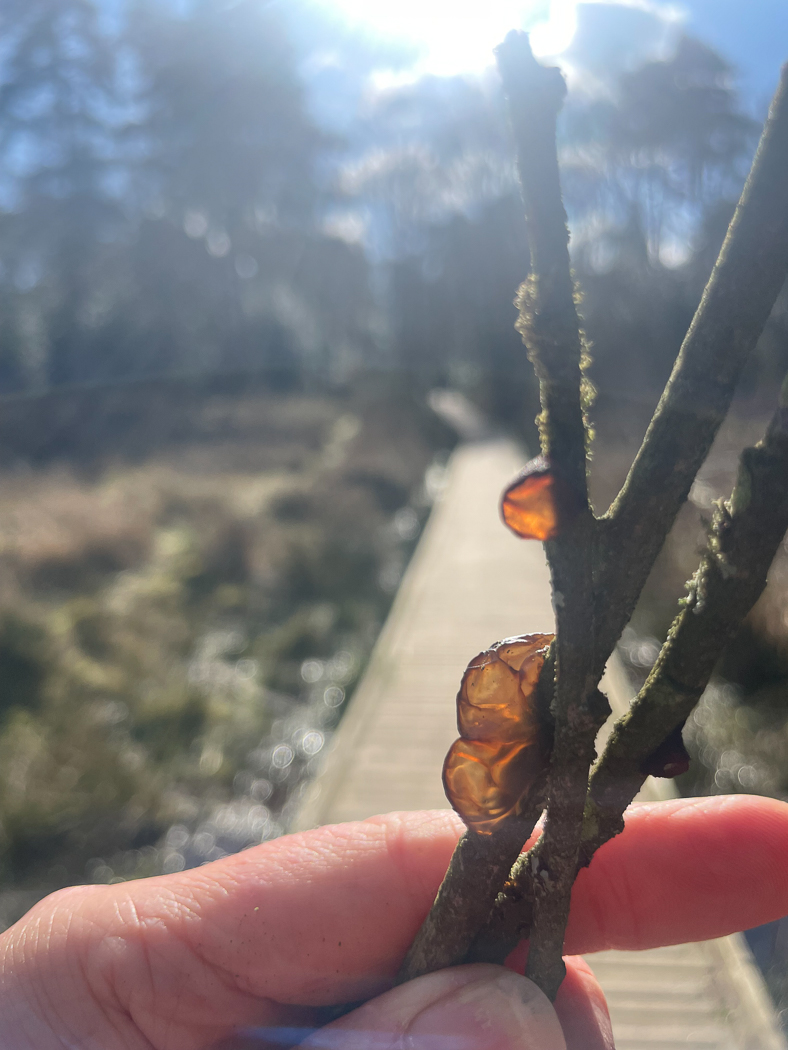
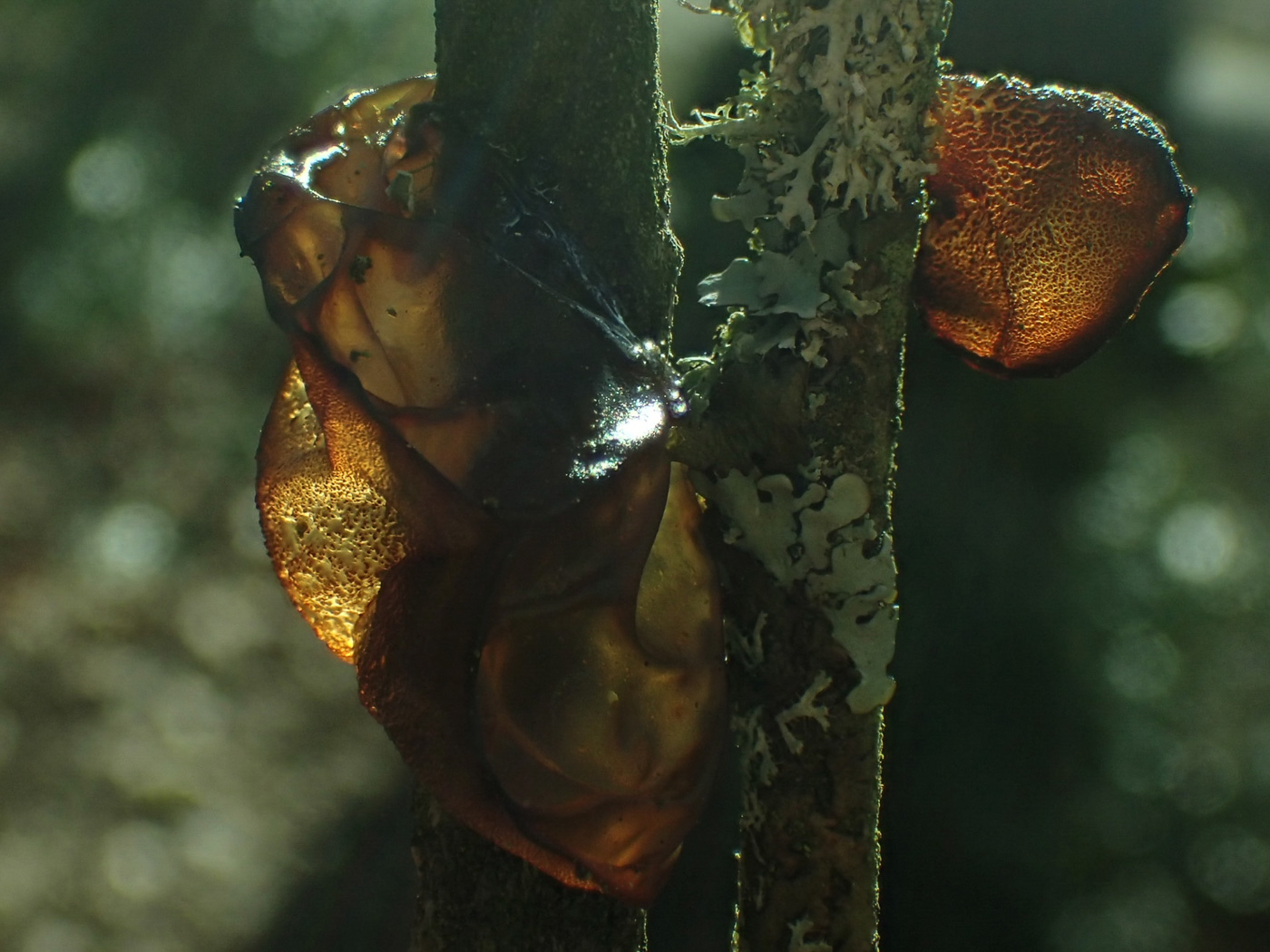
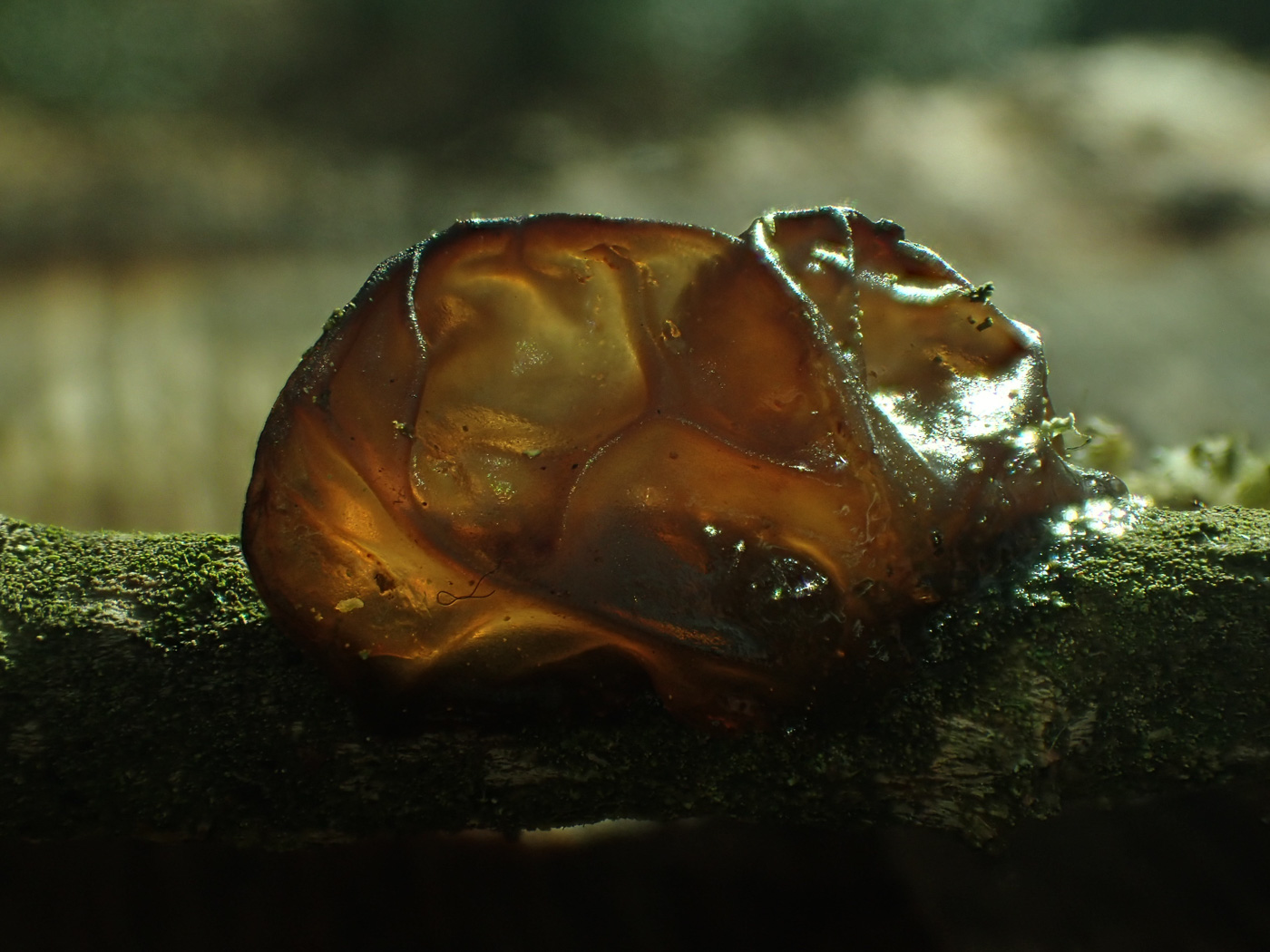
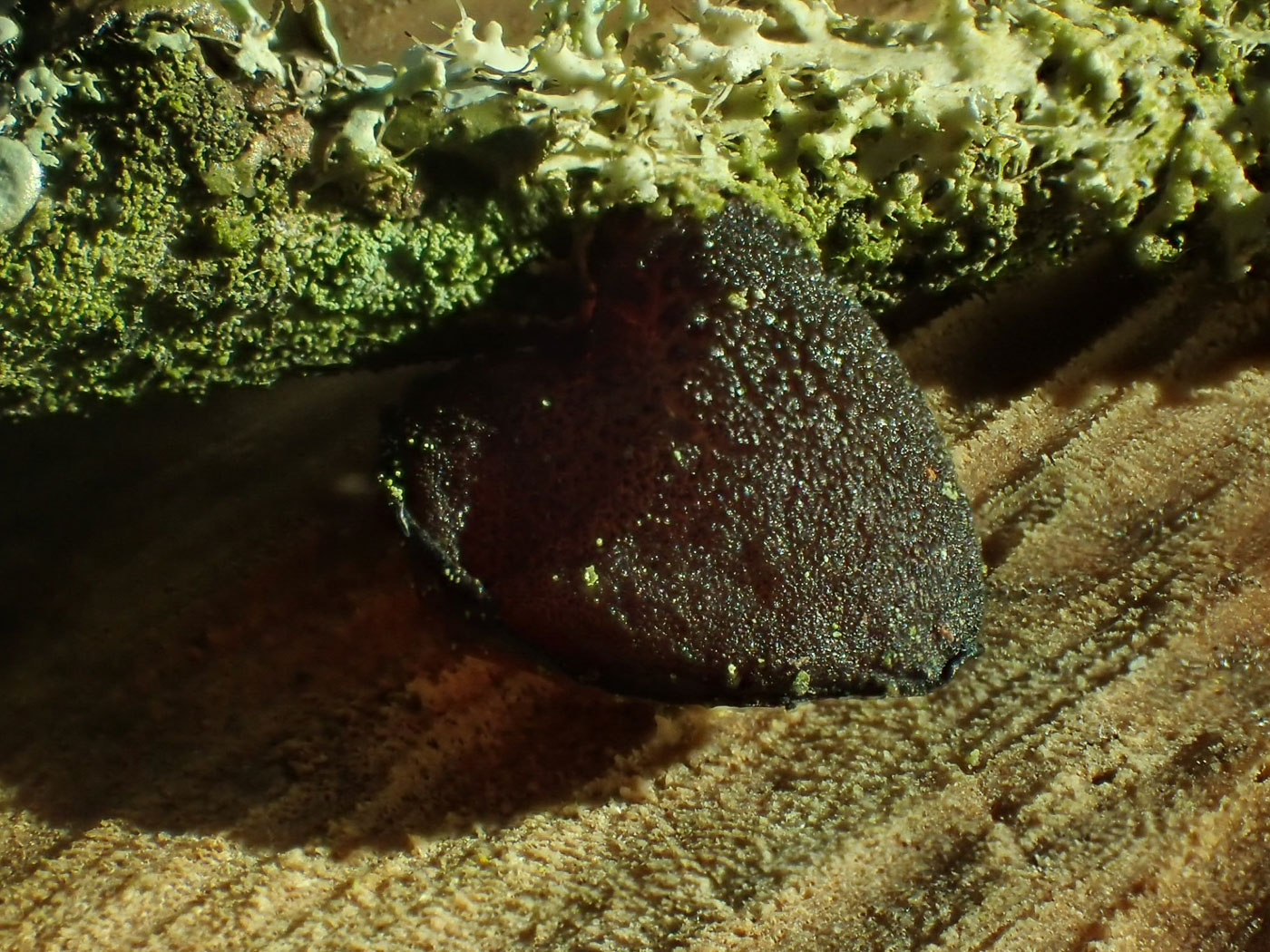
|
Feb 27, 2025. |
| Exidia subsaccharina (a newly described jelly fungus from France) | |


 |
Mar 25, 2023. |
| Exidia thuretiana (White Brain) | |

 |
Mar 12, 2024. |
| Exidiopsis effusa (Hair Ice Crust) | |

 |
Jan 15, 2024. It's almost a year to the day when Claire Williams sent Penny her photos of this beautiful phenomenon found on fallen wood near Lane End. Suspecting the recent frosts would have triggered this to happen again, she and Sarah Ebdon returned to the site, finding it here again for the fourth year running. See last year's comments for further information. |

 |
Jan 17, 2023. After several very frosty nights, Sarah Ebdon and Claire Williams felt it was worth a visit to a site near Lane End where this remarkable phenomenon is known to occur given the correct conditions. They were rewarded with plenty of examples and were spoilt for choice! The full explanation for this remarkable formation has only been uncovered in recent years when it was realised after extensive study that it only forms on frosty damp days on fallen dead wood which has this fungus on or within it. (If you'd like a fuller explanation Penny has a short article she can email you.) |




 |
Jan 6, 2022. In Lane End Claire Williams took these fabulous photos of what is known as Hair Ice, a rare phenomenon which can form on fallen sticks in frosty weather when conditions are perfect for its formation as they clearly were last night! See also her photo when she found it here last year in Finds 2021 dated Jan 8th. Photo 2 here shows how the bark of the twig has been lifted off by the ice as it forms. Also it's worth taking a look at member John Tyler's article entitled 'The strange case of the ice-making fungus' on the Articles page on our website, written several years ago, which sheds more light on it. There is much more online about it as well. One can't see the actual fungus within the wood but as it is now proven that it is responsible for causing this beautiful white moustache-like icy growth, it must be present! |
 Lane End 10.01.2021 CW.jpg) |
Jan 8, 2021. Claire Williams has found a beautiful example of a rare sight known as Hair Ice (also Ice Wool / Frost Beard) in Lane End. It is only in recent years that the fungus responsible for this phenomenon, a 'Jelly fungus' called Exidiopsis effusa, has been identified and these amazing ice crystals only form on wood affected by this fungus in really moist icy conditions - exactly what we have been experiencing recently! To learn more about this fascinating process there is lots of information online including several videos on 'YouTube' which are well worth seeing! |
| Exidiopsis galzinii (Unbleached Jellytot) | |
 |
Oct 12, 2022. |
| Exidiopsis grisea (Grey Jellytot) | |
 |
Oct 29, 2022. |

